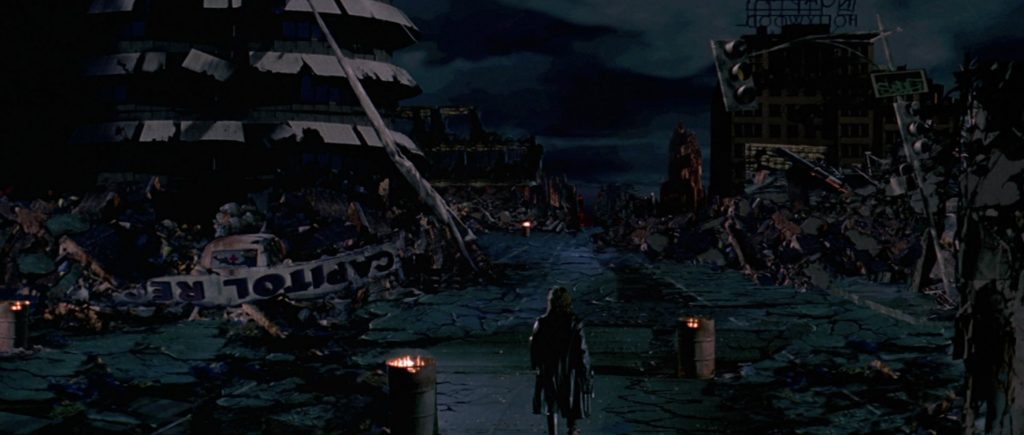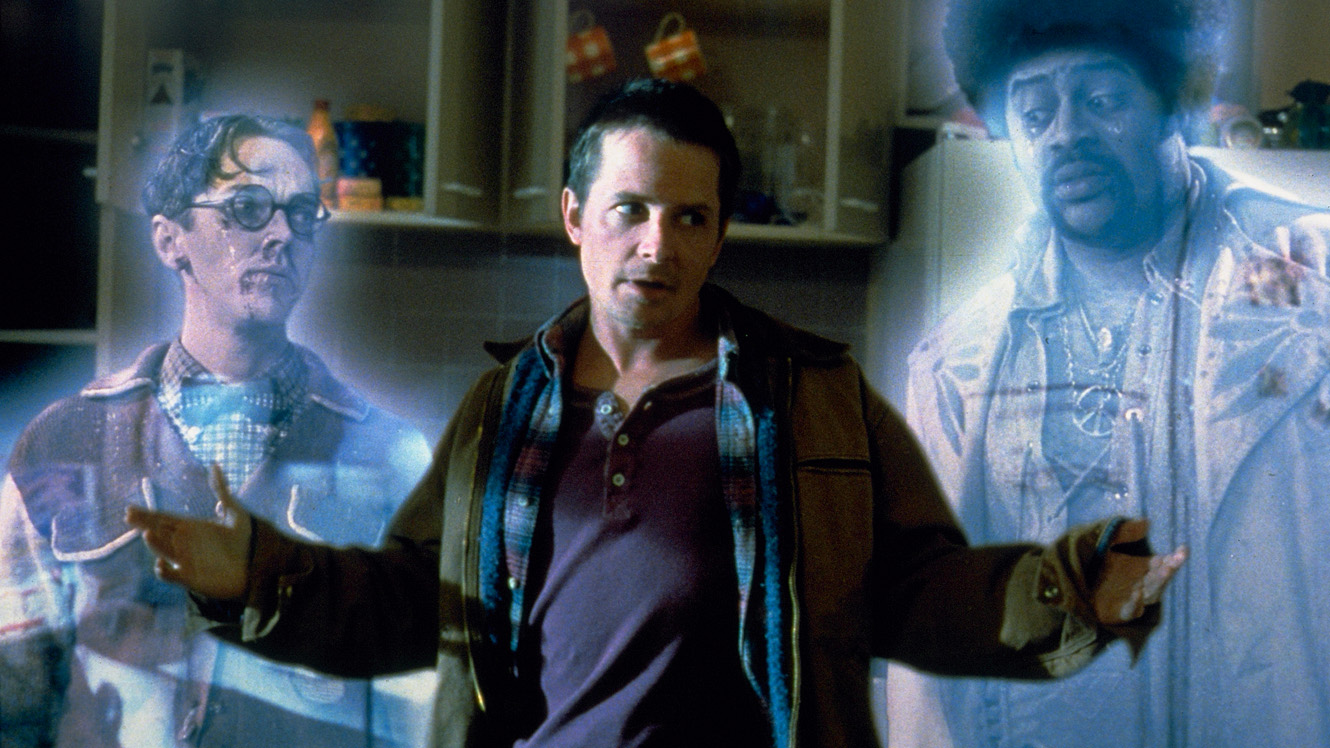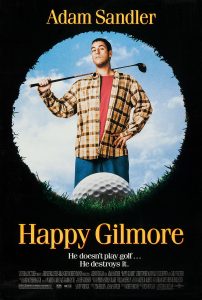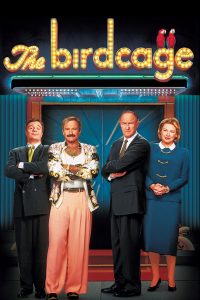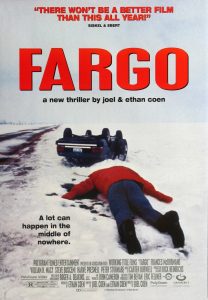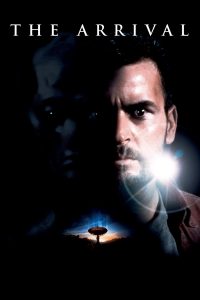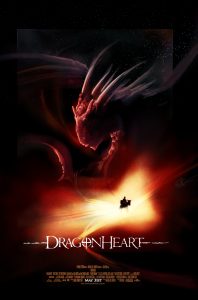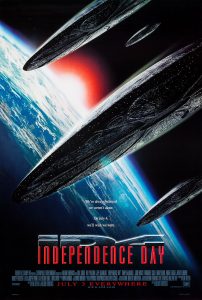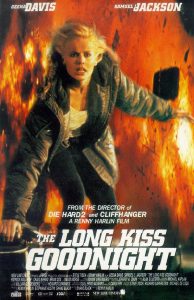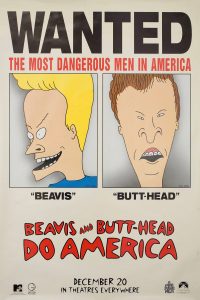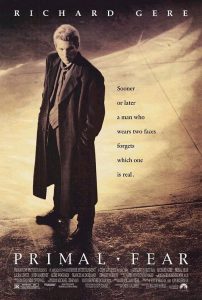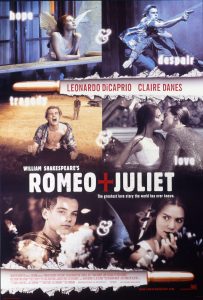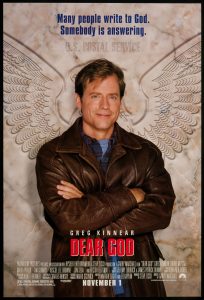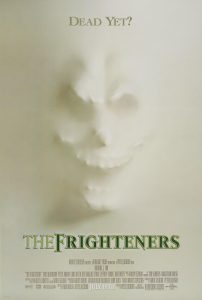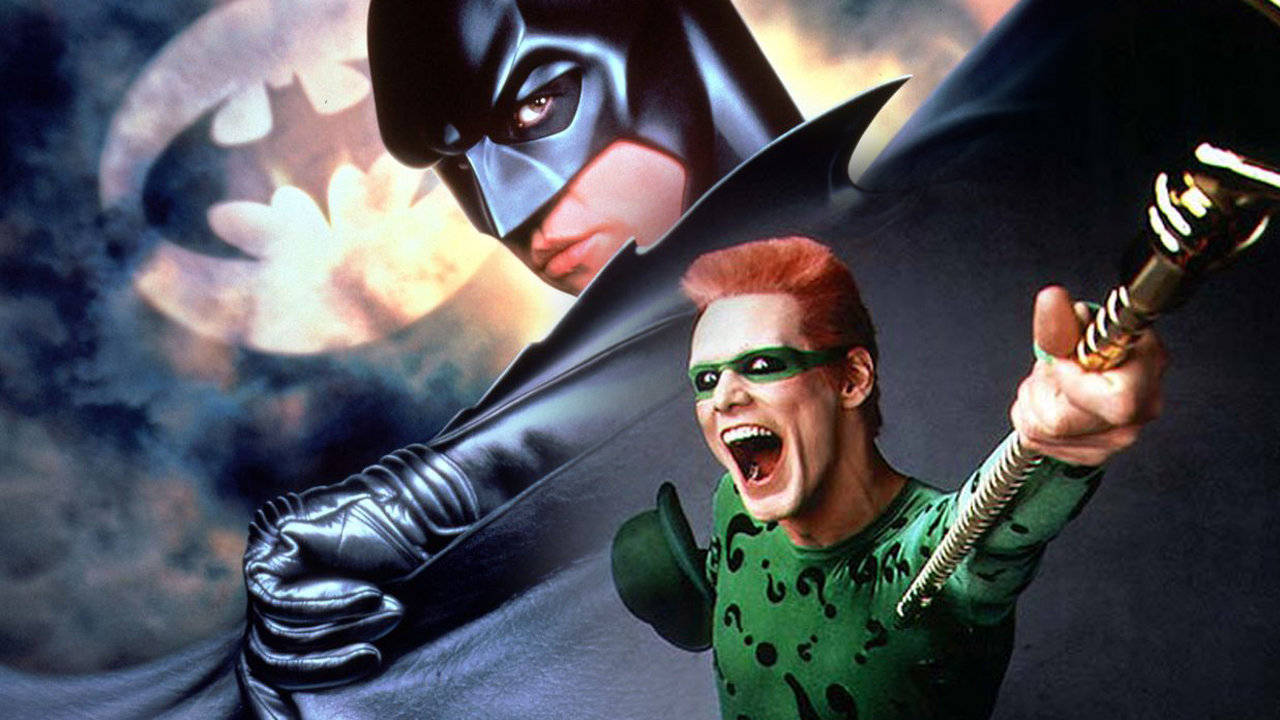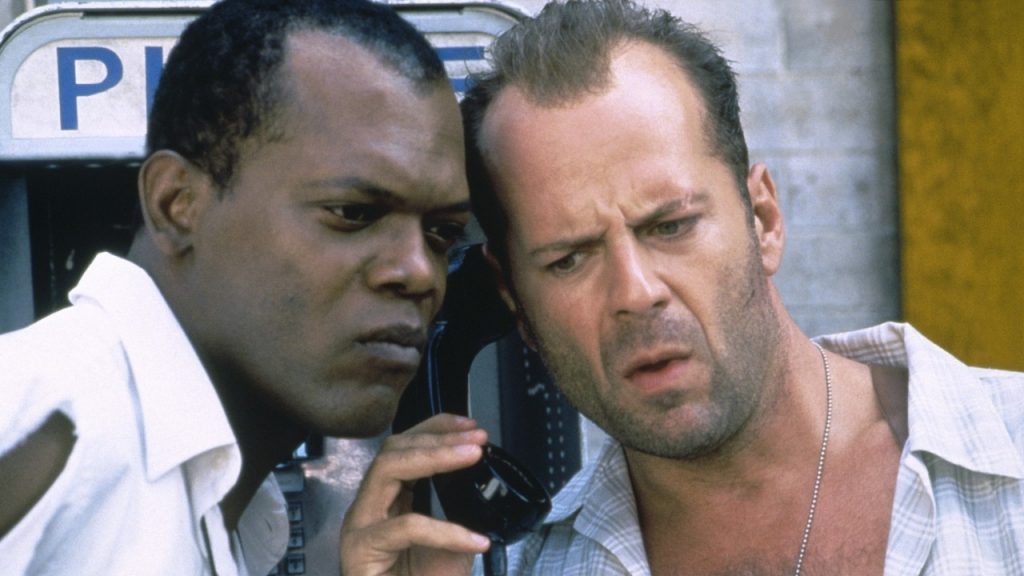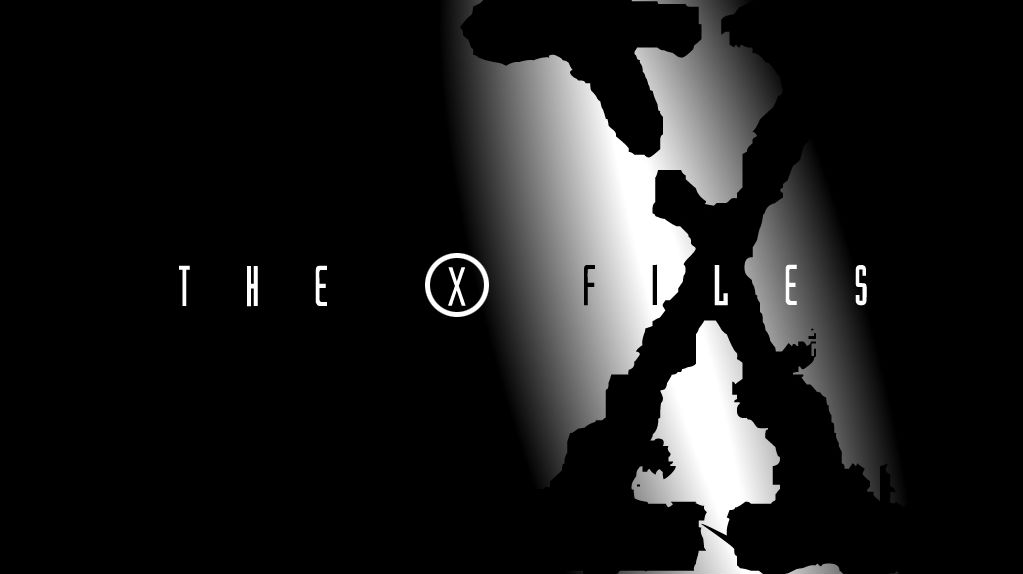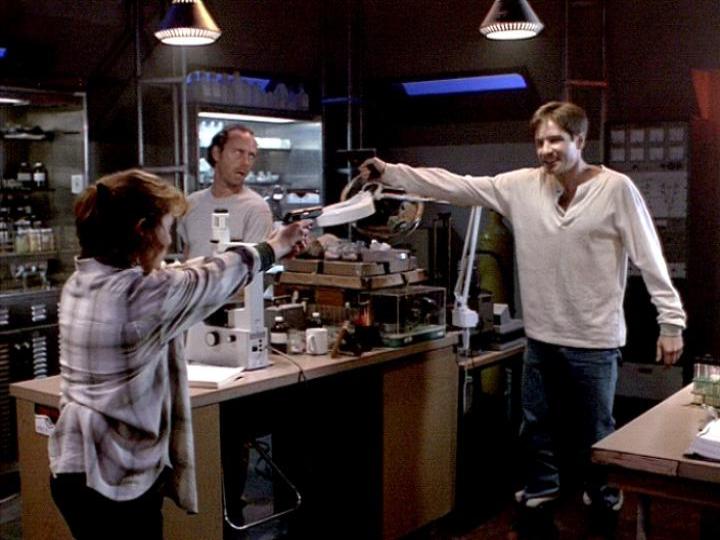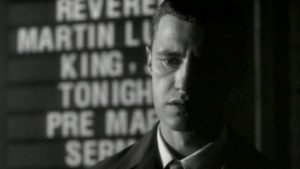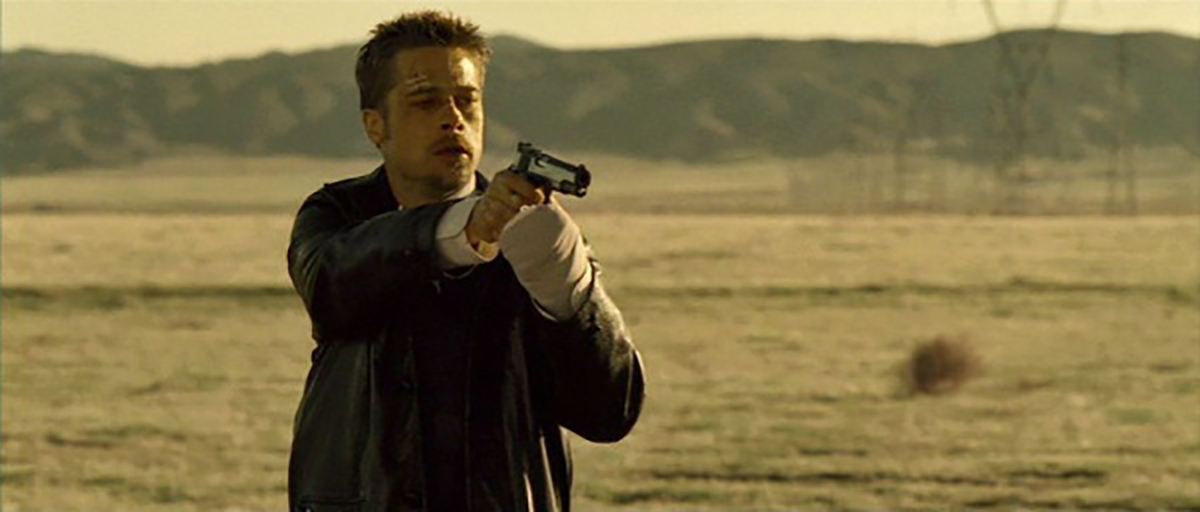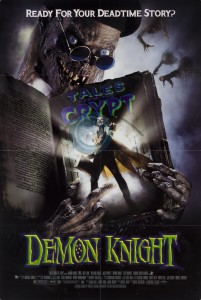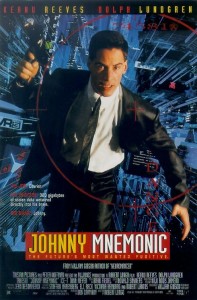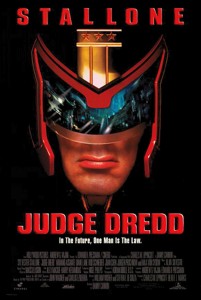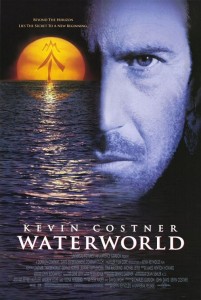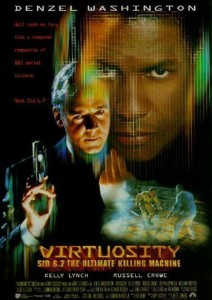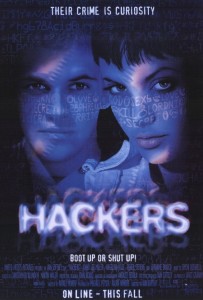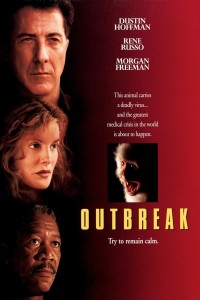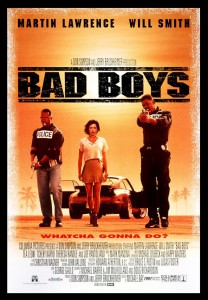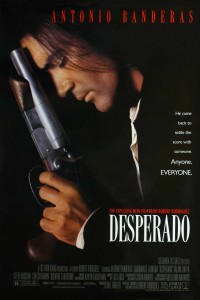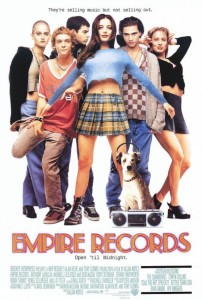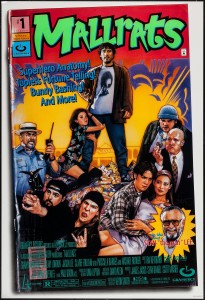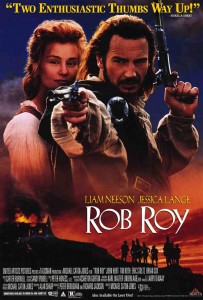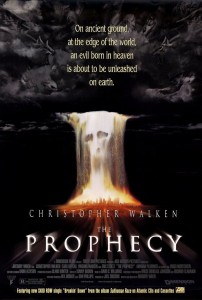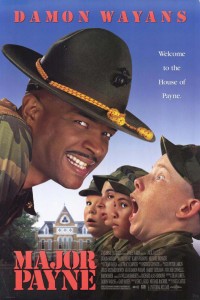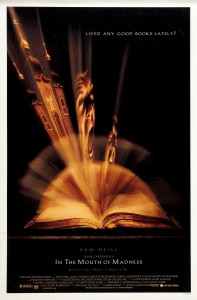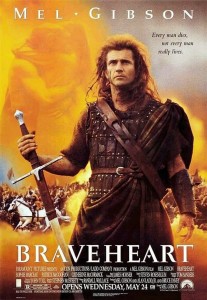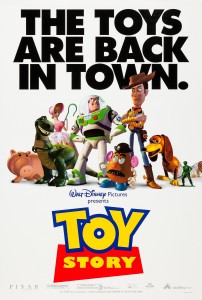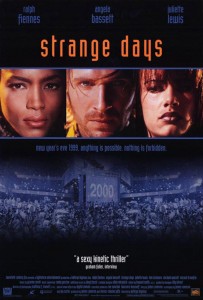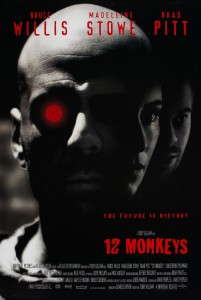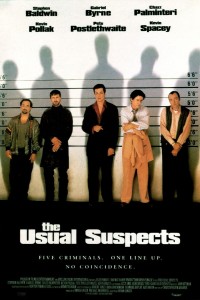So Where Were Things In 1996?
1996 started with Philadelphia and its greater metropolitan area (including my hometown) seeing one of the worst blizzards in the history of the East Coast. It closed down New York, Philadelphia, and Washington D.C. for several days – to say nothing about the canceled week of school I got as a result (this came to be called ‘Martin Luther King Week’). That May, my high school career ended, and I transitioned into the working world before going to college. I spent two-and-a-half months working as a busboy at a country club, then later as an employee at Blockbuster Video until late spring of 1997. I attended my first quarter of college in my adoptive city of Philadelphia starting in late-August. Everything was new. I found out who I was when I was truly allowed to be on my own. I spent a lot of time in Chinatown. I spent too much money from my summer job at Tower Records and Showcase Comics on South Street. I found the food carts that wouldn’t give me food poisoning in the shadows of Liberty Place. My friends and I also frequently exploited an establishment that delivered pizza and beer without even the pretense of checking an ID. I had my first nights with booze aplenty, both home and away, and experienced my first all-night parties (with subsequent sobering at the local Denny’s). I learned to like Chinese food because it was amazingly cheap and delivery was free. I met lifelong friends whose input I value, not only pertaining the courses we took, but the decisions I made (and continue to make). Things got real in my art training, fast. I had a few good instructors growing up, but I really met some great talent in college both among my classmates and among my instructors. I also had what I consider to be my first real (though unhealthy) relationship starting that Summer. It would completely fall apart the next year after about eight and a half months – though truth be told it was probably falling apart way before then. I learned much of what I did and did not want out of a relationship after that one – enough that I didn’t seriously date again for another six years (though I’d occasionally fumble through a first date that went nowhere or get shot down about every year or so).
As far as general culture went that year, Alanis Morrisette won Album of the year at only twenty-one years old. The album, Jagged Little Pill, was regularly played in my parents’ home; not just by me, but also by my sister. It is the first album that both of us owned, and one of the few things in those years that we could both appreciate musically (or at all). The Ramones (who I’d only discovered two summers before) played their last show that year. An iconic punk band was scattered – not that it stopped several of the individual members from doing their own things and riding the ailing cash cow until it was dead. By year’s end, people finally turned their attention from the OJ trial to the JonBenet Ramsey murder. America’s appetite for tragedy has always been infinite.
On the larger horizon, Whitewater put Hillary Clinton in the hot seat as she gave defense testimony. The Fox News channel was launched to compete with CNN, lowering the bar of journalism so low that Rupert Murdoch and Roger Ailes might deign to crawl out their swamps to step over it comfortably. Yugoslavia was formally recognized by the EU after years of conflict and prolonged violence in the region (that would not stop then). Northern and Southern Ireland came to the table for peace talks, though both decided to cut out Sinn Fein and put them at the kids’ table while they did it. The Troubles would continue through the next few years. Iraq continued to be a total clusterfuck as UNSCOM was routinely denied access to assess their military capabilities and a suspected stockpile of weapons of mass destruction. And, after a decades long hunt, the Unabomber, Ted Kaczynski, was finally captured in a Montana cabin. He did not look nearly as pimp as his wanted posters made him out to be.
Technology continued its march as well. Deep Blue – an early AI created by IBM – defeated Grandmaster Garry Kasparov in a game of chess. He requested a rematch about a month later in Philadelphia in which he defeated the machine, presumably pushing back Skynet’s plan to exterminate the human race from August 1997 to sometime further back. The Nintendo 64 (or N64) arrived in Japan, paving the way for its eventual release in the US. America lost its shit and the console took off to rave reviews. Nintendo took a bullish stance on its game format as well, opting to continue with cartridge based games as opposed to embracing optical media. Somehow, it managed to hold its own against Sony’s booming PlayStation platform.
The Good, the Bad, and the Indifferent
If 1996 seemed thin in terms of movies that affected me, perhaps it’s because there were a lot that didn’t. Let’s visit those films now.
Don’t Be a Menace to South Central While Drinking Your Juice In the Hood (Indifferent) – The Wayans Brothers produce yet another of their endless parade of spoof movies, this time taking a shot at Menace II Society (1993), Friday (1995), and a handful of other African-American films. I laughed, I think.
Broken Arrow (Bad) – John Travolta steals a nuke, Christian Slater has to get it back while engaging in a forced romance. Fresh off his ascension back into the Hollywood scene, Travolta makes as bad a movie as Pulp Fiction was good. It at least has one memorable line.
Muppet Treasure Island (Indifferent) – The Muppets latch on to another classic story and people it with scruffy puppets. To be fair to the Muppet franchise, I can’t honestly tell you if this was good or bad. I was in a darkened theater while the film played. That I can claim with certainty. The problem was that I was also watching the imminent implosion of one of my best friend’s relationships in progress just two seats down from me. I hope to some day see this film without a fight in progress to gauge if this or Muppets From Space (1999) marks the decline of my devotion to this franchise.
The Truth About Cats and Dogs (Indifferent) – Another rom-com love triangle in which people lie about who they are in the belief that people will magically fall in love with them. My wife and I watched this about two years ago. It’s okay.
The Craft (Bad) – Four girls do magic to become powerful and popular. This is another film so many of my friends love that just didn’t grasp me. Neve Campbell should have been enough to sell it for me, but her appearance in Scream was much better.
Twister (Indifferent) – Bill Paxton chases tornados in a special effects showcase film. It’s a standard disaster movie, though it was impressive on the technical side of things. It got a few awards to that effect as well (Best Sound, Best Special Effects). It also took home a fair chunk of box office money for the year, coming in at the number two slot for money earned behind Independence Day (1996).
Mission Impossible (Good) – A reboot of the classic television show of espionage and spycraft. The MI movies are generally fun – at least for a few films. They pulled off a lot in this one in terms of great effects and action sequences. Mostly, I love the updated theme song, a derivation of the original theme with an electronic edge. It was good fun, but nothing groundbreaking or impactful for me.
The Phantom (Indifferent) – A D-list (super?) hero film. Billy Zane rides a horse in a costume can best be described as the prototype design for the purple Teletubby. Superhero movies wouldn’t get good until we got X-Men (2000).
The Rock (Indifferent) – Ed Harris threatens to gas San Francisco after taking over Alcatraz. Only Nicholas Cage and Sean Connery can stop him. I watched this the first time and hated it. I then watched it a second time and felt I was too hard on it. It’s not terrible, but… it’s still just another action film by Michael Bay. As far as Bay films go, there are many, many more that are terrible in comparison. Like every single one of the Transformers films.
The Cable Guy (Good) – Still not a big Carrey fan, but he does a great job in this incredibly dark comedy about a lonely (and deranged) cable repairman who increasingly stalks Matthew Broderick. It’s worth a viewing for the Medieval Times scene all by itself.
The Hunchback of Notre Dame (Indifferent) – See also, Pocohontas. Only this time, they milk a public domain story lots of people know already, and, again, take incredible liberties with it to make it friendly for the kids. I did have a hilarious moment though watching this film with one of my close friends. He noted, with my mother in the room, that Esmerelda was pole dancing in one of her musical numbers. My mother immediately fired back with “And what would you know about pole dancing, young man?” He immediately blushed and said, “Uh… nothing, Mrs. Hop.”
The Nutty Professor (Indifferent) – This wasn’t exactly the start of Eddie Murphy’s slide into irrelevance. But, after this, the tenor and tone of his films started to get less edgier than he was known for. Haunted Mansion (2003), in my opinion, is when the slide truly cemented itself.
Phenomenon (Good) – A sad but interesting tale of a man whose tumor makes him super smart, and eventually psychic. I consider this Travolta’s counterweight to Broken Arrow (1996) for the year.
Courage Under Fire (Good) – A military drama starring Denzel Washington and Meg Ryan. I almost forgot that I watched this. I remember it as being pretty good, though admittedly my memories of it are hazy. I watched it with mom and dad on one of the weekends I’d returned from my apartment in Philadelphia. Probably another Blockbuster rental.
Bordello of Blood (Indifferent) – Vampires versus Dennis Miller. Meh. This was kind of a let down. This is what happens when your leading role is played by a conservative gasbag who left his best work behind in Saturday Night Live. I don’t remember much of Demon Knight (1995), but I do remember it was better than this.
Escape From L.A. (Bad) – Snake Plisken is back. He’s more or less doing the same thing he did in Escape From New York (1984)… only worse. Don’t do this to yourself. Save yourself from the ninety minutes of crap-fest you’d otherwise have to wade through.
The Crow: City of Angels (Bad) – Another guy who isn’t Eric Draven comes back from the dead with the same deal from The Crow (1994), but doesn’t make it nearly as interesting. It’s not great, and Iggy Pop and the rest of its forgettable cast fails to save it.
Bulletproof (Bad) – Adam Sandler and Damon Wayans form an unlikely pair in this action comedy about witness protection and personal betrayal. Thus began the crap movies of Adam Sandler’s career. Don’t get me wrong. I love me some Adam Sandler comedy – from the CDs. But, after Happy Gilmore, it just wasn’t hitting the right buttons.
Bound (Indifferent) – Two women steal a lot of money from the mob and try to pin it on one of their shady boyfirends. Every Y-Chromosome (and a not inconsiderable amount of XX Chromosomes, too) in the world rented this one to watch Jennifer Tilly get it on with Gina Gershon in this crime thriller. Despite that concept, this movie failed to deliver much that was memorable for me.
The Ghost and the Darkness (Good) – Lions eat people in Africa. Which sounds unsurprising, despite that they don’t usually develop a taste for long pork. But, when they do… Jesus. Val Kilmer and Michael Douglas pull of good performances in this film. Scarily enough, it’s based on true events.
Michael Collins (Good) – Again, I wouldn’t go about buying my history from Hollywood, but this was still a pretty good film covering the life of Irish Patriot, Michael Collins. Liam Neeson, Alan Rickman, and Julia Roberts all star.
Sleepers (Good) – Molested and tormented kids get back at the the people who abused them while in juvie. I didn’t catch this one in the year it was released. When I finally got around to it, I thought it was a pretty solid drama.
Ransom (Indifferent) – Mel Gibson wants his son back and acts like Mel Gibson to do it. This was another date movie where I didn’t so much care about what was going on as I did being in a darkened place with a girl.
Space Jam (Bad) – A ‘basketball’ movie where there’s only one human player (Michael Jordan). The rest of the players are animated aliens and Looney Tunes characters. It was a technical experiment, as well as an attempt to sell a lot of Nike products. It was also trying to keep Looney Tunes relevant. Not really sure it did any of those things too well. Just remember: Larry Bird isn’t white, per Bill Murray.
Jingle All the Way (Indifferent) – Arnold Schwarzenegger goes to great lengths to make sure his kid gets the big toy of the season for Christmas. This holiday film has a cult following and… I guess I’m just not a member of that particular cult. It’s okay to watch, but I don’t really seek it out.
Star Trek: First Contact (Indifferent) – The Enterprise crew from Star Trek the Next Generation follow the Borg back in time to prevent them from assimilating the human race. Another longer episode of Star Trek, again. It’s okay. I like the Borg enough I guess. But it wasn’t particularly memorable for me.
Sling Blade (Indifferent) – Billy Bob Thornton plays a mentally disabled man who does stuff he shouldn’t, both in his past and in the main narrative. Then he calls for a hearse.
Jerry Maguire (Indifferent) – Tom Cruise romances Renee Zellweger and also yells into a phone at Cuba Gooding Jr. This movie haunted me for months. Not because of any stirring drama, but because I had to ask every customer at Blockbuster if they wanted to pre-order it when they reached my counter. I got the most pre-orders for the film though, and as a prize got fifty dollars. This pissed of a shitty manager who earlier in the year accused me of stealing from the till (an error on my part let a customer off the hook for a twenty dollar late fee, not dipping my hand in the cookie jar). The fact that he had to put up this money from his own pocket – more than double the amount he accused me of stealing – made it that much sweeter.
Mars Attacks! (Bad) – Aliens from Mars attack with weapons that have no connection to conventional Physics. It’s… pretty bad. Another case of a little Tim Burton going a long way, but slathering it on anyhow.
The House of Hooded Eyes (and Near Infinite Loopholes)
I’ve talked a little bit about my parents and their guidance of my film intake as a child in the previous posts, but I wanted to really break it down how they affected me in terms of of my cinematic upbringing. If it seems like my parents dropped the ball of were highly inconsistent in what got by them… that’s because your suspicions are correct. Balls were dropped, subversive content got through, and, sometimes, we all got surprised.
We’ll start with my mom.
She meant well.
Mom’s overall opinion was that everything should be strictly monitored. While nudity didn’t really bother her so long as it wasn’t explicit, she was not a fan of violence. In particular, she was averse to military violence. The cause was two-fold.
First, she objected to military violence after years of watching footage come back from Vietnam. She, and most of the country I think, had a belly full of war. Year after year of dead kids coming home in flag covered boxes and the most explicit war footage seen by civilians on TV will do that. A lot of folks in her generation were exhausted by it. She didn’t want to see anymore (let alone show it to her young kids), thank you very much.
Secondly, she wanted to keep either of her kids away from any glorification of the military. I assure you my mother appreciates the military because she was raised right next to it. It was about what life in the military had done to her and her family. She was a Navy brat. While she loved my Grandfather and she appreciated everything that his naval career brought, she also knew a life of moving from base to base every couple of months, never getting opportunity to be a kid. She wasn’t averse to the career itself (though she feared for my safety until I was too old to be drafted). She just hated being rootless as a kid. With all of the constant moves from base to base, my mother didn’t have any childhood friends save for my aunt. Almost her entire circle of friends come from her college and professional life. She didn’t want that for my sis, myself, or our kids.
As for dad, he was… generally lax. He took stands on things at odd angles. Violence was nothing he particularly worried about. When he would shield me from violence, it was usually from the most explicit kind involving gore or frightening images. I’ll admit that as a kid I was easily frightened, so this made perfect sense. Dad was sensitive to that more than the idea of violence or brutality. He’s a fan of Ancient Rome, so war and up-close violence is something he’s well acquainted with from reading the histories. And hey, if it’s cultural (or if dad just liked a thing) he’d let my sis and I settle down and watch what we wanted (lots of Clash of the Titans (1981) on TV, where they cut out all of the nudity). Sex he was likely to censor because he probably didn’t want to have that talk with his kid any sooner than he had to. After I was wise to what sex was, I’d gather that he continued to censor explicit images so that I wouldn’t try to go out and try anything that I saw on screen (as a dateless wonder for many years, he had zero reason to worry).
Both parents took their stances on things they felt were negative, either usually as a team or individually. Generally, stuff that got deep into racism, gang violence, exploitation, fell by the wayside unless there was something in there to instruct or had a historical bent. Mom had particular prohibitions on things she felt were blasphemous, where dad was perfectly fine with letting me watch The Life of Brian (1979). Once I’d completed my Confirmation classes, of course.
Their prohibitions left much room for either relaxed interpretations or total blindspots, though.
One of the blindspots was when I was let out to any friends’ homes. I had a lot of friends whose parents were much more liberal with their childrens’ watching habits. A lifelong friend of mine had a television in his basement with full cable hook-up right next to his bedroom (I wouldn’t get a cable ready room until 1997). We’d have weekend nights where I’d crash there for a sleepover and we’d watch all of the late night HBO we could get our hands on. A particularly memorable yet wholly glazed over memory was getting to watch Robot Jox (1989) there, as well as Demon Knight (1995), The Class of 1999 (1990), and Dream On (1990) and Tales From the Crypt (1989-96) episodes. Other friends had similar arrangements, and this got me on board with either racy content, over-the-top graphic violence, or military action films.
In other cases, there were deceptions. Kids are the best negotiators. They are relentless, they know what they want, and they know all of their parents’ buttons and weakneses. My sister and I were both skilled at this. Sometimes it was a game of wearing them down. Other times it was simply downplaying the violence, swearing, or sexy bits. There were a million ploys. Any parent can tell you these tactics work. Not all the time, mind you. Just enough times to get certain things past the gate. Especially with cable television available.
There were also accidents. My parents were often times exhausted from their jobs. Both of them worked as public school teachers. Despite what right-wing pundits may tell you, teaching is not a luxurious gig. When teachers leave their classrooms, they usually have papers to grade and papers to read – sometimes until very late. In the summer, they have to come up with the next year’s plans to justify their existence to administrators that probably don’t have the same goals in mind. Given their workaholic natures, mom and dad sometimes had errors in judgment, like the hilarious twelfth birthday party where they decided Harley Davidson and the Marlboro Man (1991) might be a great film to keep my friends and I entertained for ninety minutes. It did, but not in the fashion they had hoped for. The film probably lasted more like fifteen minutes after boobs showed up on screen.
The greatest loophole though was the one right under their nose – my Aunt’s house. Which boggles my mind. Tove and my mother speak constantly. Practically inseparable, they should have been able to wholly monitor or course correct everything my cousin Michael and I watched. It never happened though, and here’s a few reasons why:
The first reason was that Aunt Tove was a lot more lenient with Mike’s viewing habits. He got to watch a lot of stuff I didn’t, so by proximity I caught a lot of stuff mom wouldn’t have approved of. I was there having sleepovers with their family every week during the summers (and a lot of school year weekends, too). This got me a lot of military themed cartoons like G.I. Joe (1985), Robotech (1985), or Starblazers (1979). It also got me my first horror movie, George Romero’s Day of the Dead (1985) when I was maybe thirteen years old. I was horrified for weeks.
Second, Michael was a certifiable evil genius. If he couldn’t get his parents on board with certain films, he had a seemingly inexhaustible network to obtain that which he was looking for in terms of films. He was not shy about discretely sharing these finds with his friends and family.
And then there was my uncle.
Uncle Jim is awesome, and he didn’t actively contribute to this loophole. He was just great at late night channel surfing, then falling asleep in his recliner with Mike and I still in the room. This led to Mike and I getting unhealthy doses of Up All Night with Gilbert Gottfried and Rhonda Shear on the USA network. Up All Night would show some of the absolute crappiest films ever made, many of which were cult or sexploitation joints. It’s this show, some ill-advised cable selections, and my gently snoring uncle that led to Mike and/or I watching stuff like CHUD (1984), Night of the Lepus (1972) or Hell Comes To Frogtown (1988).
The floodgates really opened though in 1997. But, we’ll talk about that in it’s appropriate year’s entry. Promise.
Cinematic Sins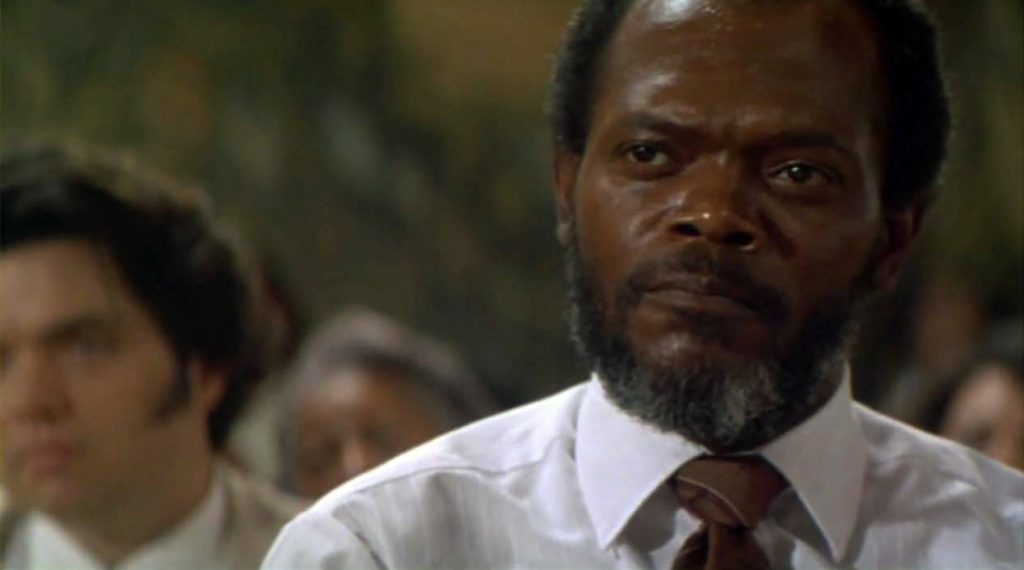
The list of missed opportunities is short for 1996. But, unwatched films from this year not non-existent. Let’s add the following onto my ‘to watch’ list:
Beautiful Girls – I had this film recommended to me by a few friends as they observed that at one point in my life it seemed like something that would resonate with me. My life always feels like it’s at a crossroad, but this looks to have a good cast. I’m adding it to my to do list.
Mulholland Falls – A noir, period piece? Jennifer Connelly? Yes, please.
Eraser – After a few tentative steps into other types of roles, Arnie goes back to starring in what he’s great at: films where he gets to shoot as many extras as humanly possible. Plus, he does it with cool guns by the look of it. I know this probably won’t be great, but I’ll probably watch it anyway.
A Time To Kill – Samuel L. Jackson yells some more in a courtroom thriller. I’m game, I guess. This film got a lot of play that year, and as a result, I know a lot of the stuff that happens. But, it’s another film like Silence of the Lambs (1991) that I feel I should watch.
The Island of Dr. Moreau – Again, I know this probably won’t be good. But, it’s a H.G. Wells adaptation. It feels wrong not to have watched it.
Last Man Standing – Bruce willis shoots people in a period piece about gang war. That’s enough for me. I’m a simple creature.
Get On the Bus – A film about the Million Man March by Spike Lee. As noted from the history segment in a previous post, the March was a relevant part of the African American experience of the nineties. Even though I remember seeing news coverage for the March, I was a white kid looking in on an experience I don’t think I was equipped to understand at the time.
The People Versus Larry Flint – Porno magnate and professional pot stirrer, Larry Flint, stands up for the First Amendment using pornography. I’m a fan of the First Amendment. This seems like a shoe in.
Graduation
For as busy as 1995 was, 1996 was a noted cooldown. There’s fewer movies that made impressions at this point. I’m not sure if it was the fact that I graduated high school, got into a longer-than-usual relationship, started working a regular job, or some other influence. Regardless of cause, this year had fewer entries than I thought it would. What the year does have a bit more of are movies that got watched that year. Timely watching seemed scattershot on previous years. There were films that didn’t get watched until late, but mostly in the next year as I got a job at the local Blockbuster Video with my own membership card.
But enough of that, let’s start with…
The Schlock
From Dusk Till Dawn
When I Saw It: 1996
What It Taught Me: Inappropriate Movie Behavior
Rating: ★ ★ ★
Two hardened criminals on the lam take Harvey Keitel and his family hostage in an attempt to smuggle them over the US-Mexico border in order to lose the Texas Rangers and Feds tailing them. Once in Mexico, they decide to lay low in a place their contact suggests – a seedy bar called the Titty Twister. Once they get there, they find out that the bar is home to a lair of vampires with a hearty appetite for carnage. The only way for the robbers to get to their payday and the hostages their release is to try to survive until sun up.
The best thing about this film was seeing it with my friend, Jimmy. We settled in for a matinee showing at the local-ish theater, waiting for all of the crazy vampire shit to happen. We get to the scene where Selma Hayek is doing her big striptease. When she morphed into her vampiric visage… Jimmy flipped his shit.
He didn’t know!
As it turns out, Jimmy went into this film blind, expecting stock Quentin Tarantino stuff. He hadn’t a clue that vampires were even a factor. After that moment, we all went a little nuts in excitement because Jimmy was now super into the film.
The bonus part of the film experience was when Harvey Keitel blesses a bunch of condoms filled with water. As noted above, we were all really wound up by this point, and I shouted “Start throwing those rubbers!” which in turn caused the rest of the gang to act up even more and probably pissed off some other viewers. It was mostly our group in the theater though (who sees a horror movie at a matinee?) so I suppose it was all in good fun.
I’d have been pissed at me now.
Happy Gilmore
When I Saw It: 1996
What It Taught Me: Absurdity
Rating: ★ ★ ★
A washed up hockey player with a penchant for mayhem faces financial difficulty after his grandmother is put in a nursing home. It’s the shittiest kind, with abusive and apathetic staff because he can’t afford something better for her. In an attempt to make enough scratch to get her moved someplace nicer, he looks to transfer his hockey skills to a high-class, money fueled game: golf. Eventually, he finds himself with a coach, a lady, and a shot at winning one of the most prestigious payouts in the sport. This is provided that he can overcome his anger issues and the smug current champ, Shooter McGavin.
For me, golf is its own joke. Have you looked at it? The pants in specific? It’s basically an excuse for men to go out into a field, drink, and avoid life for four hours while trying to put a small ball in a small hole in a large field. It’s all kind of absurd.
I know – come down off your high horse, you say. I know golf requires skill, I know it requires finesse. I know you have to be strong and smart. It just… doesn’t transfer to the screen for me (and there’s no way in hell I’m watching golf live). I’ve gone over this before. I don’t see all of that nuance. I see old, rich men in stupid pants. Usually drunk. I worked in a country club grill as a busboy that year, so I would know.
Now, add peak Adam Sandler to subvert it, thereby making it even more surreal. Hilarity ensues. This was probably my most watched comedy behind Clerks at the time. I’ve not watched it for many years at this point, but now I feel like I owe it to myself.
Somewhere In the Middle
The Birdcage
When I Saw It: 1996
What It Taught Me: Living La Vida Drag Queen
Rating: ★ ★ ★
Robin Williams and Nathan Lane are two gay men living in Miami above their nightclub, the Birdcage. Before Robin Williams came out, he was married, and he fathered a son who thinks the world of him. When his son shows up to announce he’s getting married, things get complicated. His fiancee is the daughter of a conservative Republican congressman, and a fierce defender of ‘family values.’ Together, father and son try to hide Williams’s and Lane’s sexual orientation just long enough to get to the altar. Things… go sideways in a manner only Lane and Williams can pull off.
By this point, I was familiar with the concept of homosexuality, though I had few direct interactions with actual homosexuals. We had a single girl who came out publicly in my high school class, but… I didn’t really meet anymore gay people (that were open about it) until I went to college. My folks had taught me there wasn’t anything wrong with non-heterosexual people, that there was nothing to be freaked out about. They’re right. But, there’s also a culture there that I think they still might have been a little hesitant to watch with their son in the room (ah, Protestant anxiety). Regardless, we watched this on video that year and it’s pretty good. It has a lot of range. Some would categorize this film as a comedy. There’s a lot to back that claim up given the two leading men. But there’s a lot of good drama in here too, which is the category I’d place this film in.
Fargo
When I Saw It: Circa 1997
What It Taught Me: Not a Comedy
Rating: ★ ★ ★ ★
A lot can go on in relatively small, out of the way towns. Fargo, North Dakota is not an exception, and a lot of things go terribly wrong there in the runtime of this film. It centers around a husband (William H. Macy) who looks to kidnap his wife so he can fleece his father-in-law out of a lot of money. This ends up going fantastically off track when he hires two less-than-stunning career criminals to help him with the heavy lifting. It’s up to the town’s pregnant sheriff to find out what’s going on. Bodies end up on the side of the road, and, eventually, Steve Buscemi ends up going into a wood chipper.
The film made its way to my attention during my time working at the video store. My friends had focused on the comedic aspects of it. They furthermore told me that it was must see, so when the video came off the new releases shelf, I rented it… and presented it to my parents as a comedy.
This, uh… this is not a comedy. It’s the Coen Brothers. If i had known anything about them, I would have known better. I wouldn’t really become cognizant of them or their reputation until 2000 when I saw a film archetypical of their standard modus operandi in an art history class (Blood Simple, 1984).
A fun, family afternoon was thus kind of ruined on account of my not setting the right expectations. It is memorable if nothing else for that.
So… Sorry, mom.
The Arrival
When I Saw It: 1996
What It Taught Me: Crazy and Implausible Technology
Rating: ★ ★ ★ ★
Two people discover that the Earth has been visited by an alien species. The visitors however are angling to become natives by upping the overall climate and altering the mixture of gasses in our atmosphere until it feels like home – and will kill all human life. The pair of heroes are targeted by being disgraced, blacklisted, divested of equipment, and ultimately by becoming the focus of an all out manhunt by the aliens in a cover-up effort.
This was before we all got to find out that Charlie Sheen is batshit crazy. He’s surprisingly reserved in this little-acclaimed film. I really remember being taken with it, but I don’t think it had a very good legacy. This is partially on account of alien saturation in film and television (see last article), but also by its direct-to-video sequel which failed to get the budget, stars, or writers to do anything else other than go for a par-for-the-course cash grab by Artisan Entertainment.
The thing I absolutely loved from this was the idea of the singularity bomb. The aliens had this gizmo that they could throw into a room in order to create a timed, minuscule black hole. It could swallow equipment, evidence, people, you name it, within a localized space, leaving no trace behind. Sure, there’s some problems with this conceptual device (like the whole of physics) but it was still pretty boss at the time.
Dragonheart
When I Saw It: 1996
What It Taught Me: Dragons Can Be Heroes
Rating: ★ ★ ★
After an insurrection topples a tyrant, the ruler’s son is grievously wounded. A knight to the tyrannical King makes a bargain with a dragon to save his lord’s prince whom he is sworn to protect. The boy receives half of the dragon’s heart under the caveat that the kid grows up to not be a dick like his dad. It turns out, the prince is an even bigger douchebag than his father, and he starts really screwing things up in the fief, giving the knight the impression the dragon’s heart was to blame. The knight vows vengeance against all dragons. After several years, the prince has become king, and the knight has gone on to become the best goddamned dragonslayer the world has ever seen. On a hunt for a dragon sighted in the area, he corners the beast only to discover some good news and some bad news. There sure is a dragon around – that is the good news. The bad news is that the dragon reveals to the slayer that he is the last of his kind. No more dragons.… no more dragonslaying. They manage to not kill each other long enough to develop a kind of a con since the knight doesn’t want to be out of work. They team up and begin a hustle in which the dragon shows up, does a little damage, and the knight shows up to ‘kill’ the dragon. This works well until they run afoul of the shithead prince once more and must team up to save the fief.
This film catches a lot of flak. I get the impression from most of my friends that this movie was bad, but… I don’t remember it that way. It’s got Douglas Quaid as Bowen the slayer, and (even better) it has Pete Postlethwaite as a bard following Bowen around (mostly unasked for) to chronicle his deeds. As noted before in 1992, there is nothing Pete Postlethwaite is in that he does not make at least a little better (even Alien 3 (1992).
This film did manage a little something to tweak my expectations. Up to this point, dragons were bad guys. Tolkien, Shadowrun, Dungeons and Dragons – all of those sources made dragons out to be villains, be it the calculating or simply feral kind. I mean, yeah, there was Puff, but… c’mon, he hardly counts given how dopey (and possibly high) he is. This turned that expectation for me, personally. Humans are, after all, the real monsters most of the time.
Independence Day
When I Saw It: 1996
What It Taught Me: Effects Aren’t Everything
Rating: ★ ★ ★
A mysterious signal appears among our satellites as a strange fleet of alien ships descend into our atmosphere. They hover over our largest populations centers as humanity clammers to determine why the visitors have arrived without any kind of warning. A few hours later, the signal stops and the extermination begins. Humanity unites together on the Fourth of July to defend the Planet and scourge the alien armada from our home.
This had too many big names and too much budget to go into the Schlock bucket. But, it’s close. Taking a page from the Michael Bay playbook, this film is mostly about special effects and explosions. I mean, it’s not really a big reach insofar as big summer action movies go. I remember loving it at the time. Because most hormone fueled boys are easily impressed, especially if you put them in a dark place with a girl. I think the girl I was dating at the time went to see this twice with me actually.
The film aged poorly however, and it didn’t take long. I remember being blown away by the visuals in the theater, then watching it in my apartment on VHS a couple months later. What worked on the big screen for some reason does not work on television. The effects were no longer seamless, and the whole thing seemed… cheaper. I don’t know if it was lost in conversion or if I really was just too easily impressed at that age. Maybe it was because at that time I was learning how to do the behind the scenes effect stuff.
The Long Kiss Goodnight
When I Saw It: Circa 1998
What It Taught Me: Samuel L. Jackson Cannot Be Killed; New Jersey Is Hard To Get Out Of
Rating: ★ ★ ★ ★
Gena Davis plays a woman living a happy but ordinary life. She has a husband, a child, a decent job as a teacher. She also has amnesia. She was found on a beach a few years back, pregnant, with no memory of how she got there. She’d all but given up on untangling the mystery of her old life when suddenly she begins to do things she can’t explain after a car accident. The publicity from the accident gains the attention of her former life’s acquaintances. They are not nice people. Turns out, Geena Davis wasn’t a nice person either, but now that she has a child and a husband in her life, she decides to get as far from them as possible before they get hurt. She gets tangled up with Samuel L. Jackson along the way. They go on the offensive to take out her former associates. Sam Jack swears a lot.
This was an unusual find for me. This is pretty action trope heavy – not usually a good sign. The hero with amnesia finds out she was a super spy and denounces their life of wickedness. Pretty hackneyed plot. But, it’s really good. I swear. It was really surprising seeing Gena Davis in an action role for me, and Samuel L. Jackson is absolutely great working alongside her (or did she work alongside Samuel L. Jackson – food for thought).
There were two scenes which really endeared the film to me. One reflects on the difficulty of escaping New Jersey, the other is a battle cry.
Beavis and Butt-Head Do America
When I Saw It: 1996
What It Taught Me: Absolutely Nothing, But I Still Liked It Quite A Bit
Rating: ★ ★ ★
The dim-witted duo from the hit MTV cartoon, Beavis and Butt-Head, come to the big screen! After their idiotic behavior gets them tangled up with a pair of criminals, they go on a series of misadventures through America. Beavis is once again allowed to say the F-word (and by that, I mean Fire) and many immature sexual references are made.
I’m sorry, but there’s something about these two morons that is soothing to the soul. You get the bonus of not having to think very hard to be amused, and additionally you get to see stupid behavior rewarded with the two often times getting exactly what they deserve.
They also take part in the classic fool’s journey. They wander in and out of trouble largely without ultimate consequence, yet failing to really learn anything. You know, like Congress. God bless America. Huh huh huh huh.
Personal Blockbusters
Primal Fear
When I Saw It: 1996
What It Taught Me: Edward Norton Is an Awesome Actor
Rating: ★ ★ ★ ★ ★
In this psychological thriller, a hot shot lawyer takes on a murder case. The client is an emotionally damaged altar boy accused of the killing of a publicly beloved Catholic Archbishop. The lawyer discovers the case is very complicated, and things get much more interesting when the kid sprouts multiple personalities and brazenly admits to killing the archbishop. Sensing that this is just what he needs to get the kid off charges, he pursues it, but finds out that things are not exactly right.
This really sounds straight forward. Shouldn’t be anything to write home about. Then, you get the performance that made me sit up and remember Edward Norton, who plays the altar boy. He’s just a kid in this film. But holy hell does he deliver. I remember this film chilling me down to my toes. It made me a life long Norton fan. To this day, I’m willing to give any film he does a fair shake. Even The Italian Job (2003), which I still haven’t got around to yet.
Romeo + Juliet
When I Saw It: 1996
What It Taught Me: Sometimes Updates Can Be Good
Rating: ★ ★ ★ ★ ★
Do I need a synopsis for this? Okay, here’s the sum up of the Bard’s classic tale: Boy meets Girl. Girl loves boy, and boy feels likewise. They want to get it on, but their families hate each other. They get married in secret, bad shit happens, and boy gets exiled. Priest meets girl, cooks up desperate scheme in which love might conquer all. Plan goes bad. Boy and girl die. Families grieve and rethink their blood feud. Maybe.
Oh, and the Shakespearean classic is ported to a modern setting. The dialog is chopped up and moved around, but mostly in the intended language style. Kind of.
This was a movie that arrived in an odd and fortuitous moment in which two things intersected. First, I had some Shakespeare under my belt (I didn’t go to public school for nothing), so, like some moody teenagers, I developed a thing for this particular story. Second, I actually had a girlfriend that I’d been seeing for a while by this point. Romance wasn’t a theme I investigated until then because I was pretty sure it wasn’t going to be in the cards for me after an earlier dating disaster. But, it felt like I was in love then (I wasn’t), so the movie had a little more charge in it for me.
I also had to toggle my opinion of Leonardo DiCaprio on this film. He does a solid job here as Romeo and is backed up by a great cast between John Leguizamo (Tybalt), Harold Perrineau (Mercutio – favorite role), and Pete Postlethwaite (the Priest) again! It was a good couple years for Pete in the nineties, I guess. The It Girl of the time, Claire Danes, also helped in the leading role of Juliet Capulet. Most of the young men in the nineties probably had a thing for her, and I was no exception.
As a final observation, I am not always hip to updated classics. Sometimes it works better than you’d expect, though. This was an example of when it really works. You see modern ads with antiquated language, guns named after swords, corporate logos for both Montagues and Capulets, and gangs that froth at the mouth with some vengeful sounding cries and taunts. Good stuff if over the top.
Dear God
When I Saw It: Circa 1997
What It Taught Me: It Doesn’t Take a God
Rating: ★ ★ ★ ★ ★
Con man Tom Turner (Greg Kinnear) gets sentenced in court to find legit work within one year. If he cannot keep that job for an additional year and cannot keep his nose clean in that time, he will go to jail. Eventually, Tom settles on postal work in the Dead Letter Office (DLO), believing it to be a great way to continue some side hustles. People mail valuable stuff all the time that gets lost, so it’s like a free grab bag. Tom starts opening letters for profit while posing as a model citizen. In the process, he finds a dead letter – addressed to god – in which a man declares he’s going to throw himself into the ocean to end it all. Tom comes clean to his assembled misfits (the DLO is apparently the dumping ground of the post office per his fellows) and they avert the man’s suicide after deducing a couple of clues from the text of the letter and its postal stamp. Feeling a rush off of doing something so good, they all start addressing the issues from more letters to god. Eventually they get caught and charged with mail tampering and the con man turned savior must defend himself in court.
This is not a film I’d expected to love as much as I did. I’m pretty sure this was an impulse rental – nobody at the store vouched for it. It went to the box office and completely tanked, and reviewers aren’t kind to it. I’m not really a big fan of Greg Kinnear either. The film’s pedigree is low. But, it pleasantly surprised me. For as much flak as it gets, critically speaking, anyone I mention the film to typically has a favorable view on it.
There are three scenes in particular that I love. The first is Kinnear’s first time around in court. The judge is played by a character actor we can all identify, but not by name (his name is Larry Miller and you can find his IMDB entry here). And, man does Miller sell it. After Kinnear tries to con the judge on the bench, he’s asked to approach and Miller spout this great bit about how he’s never had anyone with balls big enough to try to con a judge on the bench. I wish I could find a clip of this, but the internet doesn’t seem to care about this film. I recommend watching the whole movie just to see it.
The second is the scene where Dooley (played by Tim Conway) relates the tale of how he got dumped in the DLO by actually biting a dog.
The last was a throwaway line when Vladek (Hector Elizondo) is taking Kinnear through the post office on an orientation and points to a bright purple machine that looks like a kids slide:
Vladek: This is Barney Machine. You know why we call it Barney Machine?
Tom: Um. Because it’s big and purple?
Vladek: You’ve been here before?
And lastly, this mixes a redemption story with a personal outlook. The redemption story is easy – everyone likes those because we’re mostly wired that way as human beings. We like seeing the good rise up from someone who once was not. But the bigger thing is that it shows people doing good deeds on behalf of an unresponsive god. I am on the fence about sky fathers, benevolent creators, and punishers of the wicked on a cosmic scale. I’d like to believe – but, it would be a tremendous relief to just know. I lack faith in the theological arena. It may seem bleak, but it appears to me that if there is a god, it is highly likely that it is indifferent to us at best (in fact, it may even be Durden-esque per Fight Club (1999). So, when people take up the reins of that indifferent watcher in the sky and start assisting the people doing the god-asking… that feels good. People taking responsibility for each other is uplifting. It feels just in a concrete way that ‘giving it up to god’ does not.
Even if it is super illegal how they go about it.
Scream
When I Saw It: 1996
What It Taught Me: Horror Tropes and Lots of Them; Kill the Headliner
Rating: ★ ★ ★ ★ ★
A small town is plagued by a series of brutal murders. The victims are mostly young high school kids, and the police are baffled. This all has one teenage girl, Sidney (Neve Campbell), particularly freaked out. Her mother was murdered a year ago; the new killings seem to have some similarities. Rumors fly, and the kids get to making suppositions about how it all feels like it’s a horror movie. Horror movies have rules, right? And if you follow them, you won’t get killed by some serial slasher, right? Well… maybe, maybe not. The film gets increasingly meta the further it goes, and ramps up to a conclusion that is predictable, yet wholly engaging.
Horror was starting to get a more steady repertoire in my viewing diet by this point. While I went in (and still do) for less-is-more style films like The Haunting (1963), or Stir of Echoes (1999), I had (and still do) a general lack of one of the more popular horror sub-genres: slasher films. This is a lampoon of that sub-genre, and it more or less gave me the template for the it without really having to hit any other works. I still have seen zero Jason or Freddy movies, and have seen only a single Halloween film (the original Halloween (1978), which… left me with a flat impression. Slasher flicks aren’t my thing, but this was different and very tongue-in-cheek.
This really got a second sub-genre going: Meta-horror. In this film type, the characters are just short of realizing they are actually in a horror film. They recognize horror tropes and either try to follow them to survival, or subvert them enough to make things interesting. It’s kind of fascinating – but it can wear off quickly.
It’s arguable that the film’s biggest shocker was the decision to kill off Drew Barrymore – one of the headlining performers – within the first ten minutes of the film. She’s a big name who’d you’d expect to get plenty of screen time given how much it costs to hire her. But if there’s one thing we know about Wes Craven, it is that he does not give a good goddamn about what you expect.
The Frighteners
When I Saw It: 1996
What It Taught Me: How to Build an Underworld; You Can’t Keep a Good Canadian Down
Rating: ★ ★ ★ ★ ★
Frank Banister is a con man with a unique hustle. He styles himself as a paranormal investigator, which is half true. He’s not much of an investigator, but he can see and interact with the spirits of the departed after experiencing a near-death encounter in a car accident that he – but not his wife – survived. He has four ghosts that he uses to stage hauntings which he then conveniently shows up to solve. Together with his band of ghosts, he manages to hustle successfully until a particularly nasty spirit, the Soul Collector, begins to kill with great frequency, laying suspicion on Frank for his spectral crimes. Beyond that, the malevolent spirit’s activities reopen Frank’s old wounds and personal secrets as the story advances toward grim and shadowed paths.
This is a film I feel is vastly underrated. Of course, I love ghost stories. It’s not a stretch that this was my best film for 1996. I really liked the internal logic of the way spirits worked. Some were weak, some were strong. There was an implied social structure enforced by cemetery guardians. It meshed well, it was consistent, and more importantly it was entertaining.
The truly amazing thing though was the change of tone as the film progresses. It starts slow and light-hearted. Sure there’s dead people involved, but they provide comedic relief and everything sets up as wacky and a little off color. By the time you reach the end, the film is now stark and ominous. There is evil in the region that is manifest. That evil is determined, ruthless, and calculating. The Frightners starts out comedy, but ends up horror.
As a point of interest, Michael J. Fox plays the lead (Frank Banister) and did so just after announcing that he had Parkinson’s Disease the year prior. Turns out he’d known since Doc Hollywood and it wrecked him for a while. It was a big thing during the filming, as it showed that Fox wasn’t about to let the disease keep him down.
So Where Was I In 1995
It was a pretty big year for me. It was the end of my Junior year and the beginning of my senior year of high school. Music and Art were the dominant force in my life. I was preparing to seek out a college, taking as many arts credits as I could stack in now that I had all of my prerequisites lined up for graduation. The music gang in particular became my peer group. They were and are, to this day, some of the best people I’ve known. Many of them, while not seen on the regular, are still very much like family – even if the only way we can easily speak is on Facebook.
As for the larger world around me, OJ’s murder case ramped up and was concluded over the course of ten months. It was all anyone could talk about it seemed for not only 1995, but also 1996. The verdict of the case caused as much drama as anything else did in the whole mess and everyone had an opinion; some for, some against. Kevin Mitnick, hacker par excellence was finally caught after years of social engineering and system breaches. A two-and-a-half year phone cloning, computer, and wirefraud investigation led to his arrest and landed him a roughly five-year sentence. A doomsday cult released Sarin gas on the subways of Tokyo, amplifying a fear of terrorism that would only grow once Timothy McVeigh took out the federal building in Oklahoma City a month later using easily available chemicals and fertilizer. Vietnam and the US restored relations with one another after twenty years of chilly avoidance in the wake of the war between the two. The Million Man March was held in Washington D.C., and continued the legacy of still-needed civil rights activism in America.
On the tech front, a little company named AuctionWeb set up shop in Silicon Valley and eventually became eBay, changing the way millions of people across the globe would shop. Likewise, after a first struggling year, Amazon also emerges as an online bookseller under Jeff Bezos. This was also a big year for Microsoft. They released a highly popular graphic user interface, Windows 95. Apple had already introduced a GUI for their computer, the Macintosh in 1984, a year before Microsoft even got started with their first Windows releases. Microsoft won out in the narrative though, and Windows 95 was a big factor. They gobbled up the support of all but a small percent of home and business users over the following years. Apple wouldn’t really catch up until the early 2000’s, and even then would have trouble penetrating the business sector.
There is one big thing though that really plays into the whole topic of film that happens in this year. VHS tapes in 1995 were the almost universal format for home viewing of movies and television shows. They were relatively cheap, ubiquitous, and capable of letting viewers record anything they wanted from live television. There were a couple other options. LaserDiscs were still a thing, as were the relatively new MiniDiscs. Both were prohibitively expensive however for most people, and these efforts were never really mainstream. Both platforms didn’t have a recording capability that wasn’t wildly expensive (I remember pricing for MiniDisc recorders being somewhere around $6K, making it easier to finance a car than record digitally). To add to it, the quality of the images on both platforms didn’t really even provide any concrete benefit. America was still using the NTSC format which was a cobbled together solution to keep color and black-and-white broadcasts on the same signal, resulting in a less clear picture than other options like PAL. Televisions were mostly built to support the aging format at the time and wouldn’t have been able to display a better image. Several tech companies had been collaborating, however. Their aim was to create an affordable, new digital medium for both audio and video purposes. What emerged from this was a format still in use today, though it has had a few evolutions since it’s announcement in 1995.
The format was the Digital Versatile Disc.
Within a few years, everyone would come to know it as the DVD.
The Good, The Bad, and the Indifferent
Billy Madison (Bad) – Adam Sandler plays a rich idiot who has to get an education to keep his daddy’s business (and the family money). Happy Gilmore was better in every conceivable way.
The Quick and the Dead (Indifferent) – It’s an okay western about people coming to a town in the middle of nowhere for a gunfighting competition. People get shot, morals are generally absent, and, ultimately, they shoot Leonardo DiCaprio. Gene Hackman is in it as yet another insufferable bastard on the frontier (Unforgiven anyone?).
Tank Girl (Indifferent) – It’s a post-apocalyptic world where water is scarce and everyone fights to get it from one giant corporation. Lori Petty plays the eponymous Tank Girl, and carries the fight to the water hoarding Malcolm McDowell. I can’t really say it’s great for me, but it’s not bad either. It’s campy, and I get to see Malcolm McDowel drain a guy of all of his water with a high-tech, collapsable bottle. It’s also my wife’s favorite movie.
Die Hard With a Vengeance (Good) – A piece to redeem the franchise, DHWaV came out swinging after a lackluster second entry (Die Hard 2, 1990). This time, Hans Gruber’s brother is out to steal a lot of money while also killing his brother’s murderer: John McClane. Featuring Samuel L. Jackson as a hapless (and constantly swearing) bystander caught up in Bruce Willis’s crazy life, this film is one of the two films in the franchise that I truly love.
The City of Lost Children (Indifferent) – This was a curious little title from France starring Ron Perlman. That should rank it much higher than it is, but to be honest I just don’t remember anything from it apart from its great trailer music and general weirdness. Perhaps I shall revisit it to place it in its proper category.
Congo (Indifferent) – Gorillas. Or was it apes? Something about a diamond and a laser too. I don’t care. This was a largely forgettable film without nearly enough primate fighting to catch my attention.
Batman Forever (Bad) – Batman fights Two Face and the Riddler in this lackluster abomination. Boooo! Joel Schumacher should be ashamed of himself. Pretty decent soundtrack though.
Pocohontas (Indifferent) – The greatly modified story of Pocohontas and John Smith. Another Disney children’s feature that manages to get history, in general, wrong. I suppose it was well animated.
Species (Indifferent) – A sci-fi film about a genetic hybrid between man and an alien with a whole lot of tentacles. It had a lot of promise (H.R. Giger designed the creature), but ultimately fell flat. Well, except for the part where they get Forrest Whittaker drunk. That was pretty funny.
Kids (Good) – Kids in the age of AIDS awareness get up to heinous trouble and give each other HIV. This film left a bad taste in my mouth. I suppose it was designed to be that way on purpose. The ending will hit you in the gut. This makes it objectively good because it left an impression, but… you’ll only ever need to watch it once. In my opinion, the song ‘Natural One’ by Folk Implosion is the best thing about the film (you don’t need the soundtrack or any of Folk Implosion’s other work).
Dangerous Minds (Indifferent) – Another case of a good teacher bringing around a bunch of wayward, at-risk students. It’s formulaic and soundtracked by Coolio. You could do worse. But, in the face of Lean On Me, this film just isn’t as good.
Mortal Kombat (Bad) – Don’t. Just don’t. Play the video game. I don’t think there really was a plot here save for putting together fight scenes with mostly bad actors. The soundtrack is amazing (still in my regular rotation). But seriously? Christopher Lambert as the Japanese god of Thunder? Nope. Not. Buying it.
Get Shorty (Good) – I’ll be honest, I don’t remember much of this one, though I remember laughing and having a good time watching it. It’s almost impossible to not enjoy a Delroy Lindo film. Solid cast. I ought to refresh my memory on this one too.
Powder (Indifferent) – Sappy, but all right, I suppose. An outcast kid with weird powers changes people’s lives. Or something.
Goldeneye (Indifferent) – Gonna take some heat for this… I don’t care about James Bond. Old Bond. This bond. Daniel Craig Bond. I just don’t care. Something about a Russian satellite in this one I think? Two hot girls, one good, one bad? Meh.
Heat (Bad) – A crime drama featuring a cat and mouse came between Al Pacino and Robert DeNiro. Given those two names, this should have been great. Two American film legends playing against one another. How does this go wrong? His name is Val Kilmer. Which should have been a win. I’m not sure why, but he has all of the performance ability of a wooden plank in this and I cannot fathom why. I can’t hate him though. His Doc Holiday is the best and it earns him credit for more or less any other less-than-stellar job.
Casino (Good) – Joe Pesci murders people who get in his way as he runs a crime empire from a casino in this overly long film. I rented it while I was working at Blockbuster Video and it was good, but wasn’t a huge deal for me.
Jumanji (Indifferent) – A board game comes to life, destroying the home of its owners and taking them on a magical adventure through a jungle dreamscape. I was a little old for this by the time it was released. Never grabbed me like it did some of my younger friends.
Grumpier Old Men (Good) – Older, grumpier, but not better. The same plot from Grumpy Old Men is born again but with more hilarious Burgess Meredith outtakes.
A Trip To Television – The X-Files
This series is about films and how they followed me through formative years, but we’re going to take a brief detour again. We did soundtracks last time, but this time we’ll take the small screen over the silver one. I could talk about all of the cool TV shows from the nineties, but I’m going to single out one. Because, at the end of the day, none of the others matter all that much for me. The biggest and best was the X-Files.
As noted in the Outbreak review, trust in the government was pretty low in the nineties. We no longer put it beneath most of our elected officials to do shady business, or to even actively work against its own people. This came from a lot of sources – Watergate and Vietnam being two of the most prominent catalysts in the decline of trust- and it colored a lot of media in the eighties and nineties. There was this weird undercurrent in the 90’s that focused on whether or not we had been visited by aliens in the 1940’s. It was about as close as UFOlogy came to being mainstream, and the X-Files just happened to catch the lightning.
I didn’t know it at the time, but the show drew not only a lot of tropes from Twin Peaks, but a lot of cast as well. Duchovny’s breakout had been on Twin Peaks where he played Denise, a transgendered undercover cop. Watching the show now (and having watched the original two seasons of Twin Peaks as an adult), I can see the show’s roots in almost every episode of the first twenty. I don’t think that the show would have been half as ambitious without Twin Peaks to show what was now possible in the medium.
A Change In Format
To my memory, most television shows were not in the habit of practicing strict continuity, favoring a new, complete story in every episode. Mostly I write it off to lazy writing. When you’re filming escapist television, it was easy to ignore continuity beyond the staple cast unless you were in drama pieces like say Dallas, Dynasty, or Hill Street Blues. Also, there was no twenty-four hour outlet for fans to call lackluster writing out. The internet wasn’t all-pervasive yet. You were more likely to complain to your friends on AIM or post to a forum than to actually get the ear of studio types. Even if you could get through to studio types, the idea that they could get valuable viewer data and feedback from the internet hadn’t really germinated yet.
Bottom line was that my types of shows didn’t get much in way of continuity. Sci-fi was for geeks and Saturday morning cartoons. How much continuity did you really want to invest in for low-end returns? Geeks were usually poor and kids were only targeted as an audience to sell merchandise from the shows they watched (which were more often than not twenty minute commercials for toys). There were exceptions on TV (Battlestar Galactica and Star Trek were two good examples), but typically only for those with incredibly rabid fan bases (Trekkies having earned their mixed reputations well earlier).
The X-Files was different. I largely missed the first season, only having picked up on it after Jamie, an almost lifelong friend, told me about it on one of our game nights. “It’s aliens and ghosts and monsters,” he said. “Like Scooby Doo, only no dog, and the stuff the main characters chase are real. Oh, and they’re feds!” So, I set the VCR to tape the next episode that came on and was hooked after that. I want to say my first episode was either the Erlenmeyer Flask or Little Green Men – it’s been so long I can’t be sure. With either episode, it was clear that I had missed previous content. But, it was still enjoyable. There were non-story arc episodes that weren’t forwarding the mythos too. Monster of the Week episodes were plentiful. It was easy to sit back and enjoy, even with gaps in the narrative.
By the time I got to college, I could start filling in some of the blanks. They released six episode VHS packs that covered not only the essential mythos episodes, but also creator favorites. It let me cut my teeth on the basics from the Pilot and Deep Throat episodes, while also getting first season classics like Fire and Ice (Ice still being in my top ten episodes). More VHS packs followed for the second season with some episodes left out. Completionism wasn’t quite in the budget for Fox at the time I guess. The die hards were recording broadcasts at home anyway. I know I was. I still have two copy paper boxes of recorded episodes.
A Lasting Legacy – Sort Of
The X-Files was my first tried and true fandom. Everything about it was as if it had been directly marketed to me, specifically. I had my timer set on the VCR for 9:00 PM, EST, every Friday night. Then, every Thursday night when the schedule shifted. I could tell you who all of the important characters were. From the original informant, Deep Throat, the Alien Bounty Hunter (when he morphed back to his default appearance), Rat Boy (you gotta be a fan to get that one), or any of the other weird recurring characters (Tooms comes to mind), I had my mental rolodex set to identify them all. Leastwise up to season six.
By that season, life had become too fast paced for me to really keep up and I sensed that somewhere in my rear view of the series, a shark had been jumped. They brought in a lot of guest writers. The episodes got a bit lazy. The set location changed from brooding Vancouver, British Columbia to bright and sunny Los Angeles, California when Duchovny got hitched to Tea Leoni. It declined in my estimation. Eventually, the fandom loosened its grip, but my love of those first wonderful five seasons stayed with me.
The show would continue on for three more seasons in the original run, nine total. By the time the show had come to a close, it had suffered several setbacks, up to and including the absence of both main characters from the cast. Mulder and Scully were replaced by Dogget and Rayes. The dynamics between David Duchovny and Gillian Andersen’s main roles were what had kept many watching for years, and I thought for sure the show would come to an ignoble end once Robert Patrick and Annabeth Gish stepped in. Yet, the juggernaut could not be stopped.
For a good ten years, the series ran. Could it have stopped? Maybe. I would have thought that the movie should have been enough to end it. With ratings like that, though, it must have felt to Fox like leaving money on the table.
The Top Five Episodes
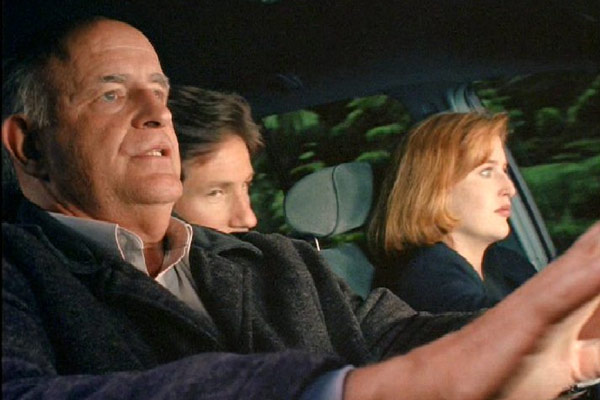
Bruckman: Well, at least I won’t die of auto-erotic asphyxiation. Mulder: Why are you telling me this?
In the name of brevity (and because top ten lists suck, per High Fidelity), I’ve taken the time to comb through my favorites and give you the highlights. It’s funny that few of them were mythos episodes. Most of them are Monster of the week deals. I was in it for the overall plot, but good goddamn if the one-offs weren’t some of the best work. The items are listed in chronological order, not by favor.
- Shadows (1993) – Lauren begins experiencing hauntings after two assailants try to abduct her at an ATM and are killed by a protective spirit. Mulder and Scully show up when the bodies are identified as wanted terror suspects. As they investigate the murders, Mulder shares his belief that Lauren is being haunted by the ghost of her former boss who was killed after he discovered one of his partners was involved with a known terrorist group. I’ve always loved ghosts, and this one had some surprisingly good special effects for a season one episode.
- Ice (1993) – Mulder and Scully are sent to Nome, Alaska to investigate why an entire team of amicable scientists murdered each other before sending out a final, cryptic video message. The culprit is a kind of ancient worm that was preserved in an ice core sample, then brought to the surface. The worms infest human hosts and trigger their fight response to lethal levels. This is a great cabin fever style episode. With nowhere to run and no backup able to arrive until a blizzard passes, the episode dials the tension up scene by scene until Mulder and Scully figure out a way to determine who is infected and who is not.
- Sleepless (1994) – A Vietnam Veteran from a squad with the highest number of confirmed kills in action appears to be murdering all of his old squad mates. All the victims however seem to show all of the secondary, but none of the primary, means of violent death, drawing the attention of Mulder and Scully. It is eventually learned that the killer was a part of a military experiment which eradicated his squad’s need to sleep. Mulder (correctly) theorizes that this experiment seems to have opened a latent psychic ability within the killer to project fatal illusions in the minds of other people. The concept of this requires more than a little magical thinking to grok, but it has been one of my favorites between the idea itself, and the portrayal of the psychic soldier by none other than Tony Todd.
- Clyde Bruckman’s Final Repose (1995) – An aging insurance salesman leads an unsatisfying life because of his psychic ability to foretell how any person is going to die. He comes under the scrutiny of the X-Filed division when self-proclaimed psychics start to be murdered in his otherwise humdrum town. Using his abilities, he assist Mulder and Scully in tracking down the killer. This episode actually won an award. It’s one of the more heartfelt, yet comedic, episodes in the series. Peter Boyle plays the role of Clyde Bruckman as well. It’s amazing, and I think that this episode is probably my favorite out of all the ones I’ve seen.
- Musings of a Cigarette Smoking Man (1996) – The Cigarette Smoking Man is arguably the primary foil of the entire series (barring the faceless aliens looking to exploit us). But, even he has a past. This episode goes through bits of collected evidence by the Lone Gunmen (a conspiracy watch group) that paint a picture of who he is and why he is what he is. It very much takes a ‘sympathy for the devil’ approach and nails it. After the episode is done, there’s some sympathy for him – but not nearly enough to wash the blood off his soul.
Cinematic Sins
It’s time to wrap this up with a list of movies that I regret having missed or seem like obvious holes in my viewing history. Given how many films from this year that I actually saw, I am sort of shocked I missed any. Here’s what I’ve got for 1995:
Higher Learning – Hell of a cast here between Omar Epps, Lawrence Fishburne, Ice Cube, and Jennifer Connelly. Not surprising I missed this film. I wouldn’t have particularly sought this out on my own even if my folks would have let me watch it in 1995. I was too into escapism for the most part, with some noted exceptions. I’ve seen bits and pieces since it’s played on TV, but I have yet to see it from start to finish.
Village of the Damned – This is probably a bad film, but I remember wanting to see it based off of its creepy trailer. I reckon this has to be on streaming somewhere for free by now.
Clueless – I initially filed this under the dumb comedy category, though I am told by many that this was a mistake. At least this is what my wife tells me. So, I reckon it’ll get watched eventually.
Lord of Illusions – I’m told this is worth the time, though with leading role being played by Scott Bakula… I have my reservations. It’s based off of a Clive Barker story though, so here’s to hoping.
Clockers – This would assist in filling up my Spike Lee film gap while also netting me a great cast. It’s another Delroy Lindo film too! Harvey Keitel and John Turturro star as well.
The Doom Generation – This film has been recommended to me over and over again by friends who know me well. I don’t know what this says about me or my friends given that it sounds like it’s about a trio of accidental spree killers, but… I’ll give it a watch for a dark and twisty entry.
The American President – I like The West Wing, and this even has Martin Sheen in it too (though Michael Douglas is actually the President). I’ll take another White House drama I guess.
Balto – An animated film about a sled dog voiced by Kevin Bacon. Sounds like there’s worse ways to spend an afternoon.
Time passes through 1995
Wow – half a decade gone by already on this project. By the time 1995 hit, I was well on my way to being a man, at least in the eyes of the law. The films kept coming though. So many films. 1995 was another great year for cinema.
We’ll get right into it this time around – I think I’ll save the ‘So Where Was I…” stuff for the cutting room floor. We all know the movies are the focus here – so, we can talk about the world and my life later to frame this year’s films.
So here we go.
The Schlock
Demon Knight
When I Saw It: 1999
What It Taught Me: Soundtrack Love
Rating: ★★★
You know… I don’t remember a lot about this film. Something about demons. A dude with a key in his hand. Not like, holding it, but the key being under the skin of his hand. A big painting with something on the other side trying to get through?
Oh yes, and blood. Lots and lots of blood.
But, for all that I blank on the movie, I remember the hell out of its soundtrack as noted in the last cutting room floor entry.
Interestingly enough, for something this schlocky there’s some names you might recognize here. I wasn’t surprised to see Billy Zane and Thomas Hayden Church in the cast. Jada Pinkett Smith was a surprise, though, as was John Laroquette.
Johnny Mnemonic
When I Saw It: 1995
What It Taught Me: Schlock
Rating: ★★★
Johnny is a Mnemonic Courrier. It’s his job to keep confidental data in his brain implants secure – even from himself. He takes on a job however that is beyond his capacity and finds himself hunted for the data he carries. The data is vital to curing a disease known as Nerve Attenuation Syndrome, and if he doesn’t get it out soon, the data will corrupt and take him out with it.
I saw this on my birthday. It was… a well intentioned gift. It was a no-brainer that I would want to watch this as it is an adaptation of a short story by my favorite author. William Gibson’s Burning Chrome short story anthology contained the story this film gets its name from. It… sort of follows the story. But it ultimately fails to deliver on a lot of fronts. The acting was bad, even by early Keanu Reeves standards (his redemption would come in 1999). The special effects… not as special as you’d hope for. The soundtrack? They got KMFDM… but nothing else of real note. This opened on Memorial Day weekend as well, the season for all-out blockbusters. This film just couldn’t hang.
It gets a few things though that scratch very particular film itches for me. Despite generally uninspired performances, they cast Henry Rollins. Not even as some random dude who they needed because Hank looks scary. He’s a doctor in this! Then there’s Dolph Lundgren as the Street Preacher. Seeing him roll up on people with a knife carved out of a crucifix shouting ‘It’s Jesus Time!’ is one of the best moments burned into celluloid ever. I wouldn’t really appreciate it until later, but Beat Takeshi is also in this film as (aurprise) a Yakuza boss. Barely speaks a lick of English. When he does, he does it phonetically by my understanding. He’s learned more since I think, but he’s so successful, he can tell directors that if they want him that bad, they’re gonna put up with him speaking in Japanese.
All three of the parts played by the actors above? Totally not in the original story. So this movie beats a stopped clock, three to two.
Judge Dredd
When I Saw It: 1995
What It Taught Me: Crazy Technology
Rating: ★★★
This isn’t quite the origin story – not at first. It goes balls to the wall within the opening credits, with Dredd doing what he does best – serving as judge, jury, and executioner as he de-escalates (read ‘murders his way through’) a Mega City One block experiencing a block war. As the story progresses, Dredd is framed for the murder of a journalist who reported unfavorably on him and is sent to a penal colony in the wretched and irradiated Cursed Earth zone. Predictably, he murders his way back to Mega City One, while also learning more about where he came from.
I have mixed feelings here as well. I like the concept of Judge Dredd, though I cannot say with full faith that I am a Dredd Head. But, even as a kid I could tell you, it was weird to see Dredd take his helmet off. The movie was a good example of how good concepts go bad because of studio choices. When you pay all that money for peak Stallone, you’re gonna get some face time.
Yet, I did like some of the tech stuff that came out of it, primarily the Lawgiver.
The reboot from recent years is a more than suitable replacement for this schlock-fest. But, it does have a special place in my heart for ‘double whammy’ alone.
Waterworld
When I Saw It: 1995
What It Taught Me: Apocalypse Building
Rating: ★★★
The Mariner (Kevin Costner) is a mutant wandering the open seas. Not that that really means much location-wise, since essentially the world is now one big ocean after an ecological catastrophe. The oceans rose drastically further than even the most liberal-swinging climatologists expected. But, if rumor is to be believed, there’s still a dry shore out there. Whispers speak of the peak of one of the world’s largest mountains still being above sea level, though most write this off as optimistic fantasy. While on the way to finding this supposed oasis of dry land, the Mariner falls under the gaze of one of the nomadic gangs with dwindling resources, the Smokers (led by Dennis Hopper).
Now, this movie gets a lot of flak. I think this is mostly because of how much money it cost not just to film it, but how much it cost to re-film it because Kevin Costner didn’t want his bald spot to show while he was underwater. When you take the budget out of the equation, what you have is an interesting (if goofy) post-apocalypse.
They handled it pretty well mostly, though there are always logistical issues I have problems with in this genre. But, all said and done, they covered mutation, resource scarcity, warlords, legends of the world before, and did all of it well considering.
The real crime here was male pattern baldness.
Virtuosity
When I Saw It: 1995
What It Taught Me: Crazy Technology
Rating: ★★★
Sid 6.7 is an artificial intelligence created for use in a proposed police training simulations in virtual reality. It’s core programming is compiled from traits of known violent criminals and psychopaths. Sid 6.7 knows what it is, and also views his existence to be a sort of prison. The programmer of the virtual spree killer has taken quite a fancy to his work though, and he decides that what the world needs is an apex psychopath made out of glass-eating nanomachines running loose in Los Angeles. Once the LAPD gets word that Sid 6.7 is loose, they send the only person that consistently beats him in VR after him: a disgraced former cop turned convict who’s been a guinea pig in the VR training project.
This is a guilty pleasure film for me. Looking back on it, I absolutely cannot tell you this is a great movie. But I was quite taken with the premise.
I don’t know where the fault lays exactly. It’s got Russell Crowe as the killer AI. That should be a point in its favor. It’s not, strangely. He overacts. Abundantly so. I don’t know if this was Crowe taking the ball and running with it, or the director asking for the excessive presentation. The effects, even for the time, were a little unpolished as well. It was the nascent age of modern special effects, so I forgive it that. Then there was the parade of B-Actors that filled out the rest of the piece including Stephen Spinella and William Fichtner. Denzel Washington (as is his way) was the powerhouse actor, and even he seemed a little dulled compared to some of his other amazingly good films.
Regardless, the idea of Sid 6.7 did take root in my mind, and the mechanics of his regenerative technology fascinated me. It made for fertile grounds for new ideas as I went on to write science fiction that focused on merging man with nanotechnology.
Hackers
When I Saw It: 1995
What It Taught Me: Nothing About Hacking (But How To Make It Look Cool), Soundtrack Love
Rating: ★★★
When you breach over one thousand systems and cause the NYSE to drop a couple points as a result, the law takes an interest. Zero Cool did just that, and as a result he got slapped with a lengthy probation on account of being a minor. He’s served his time, and the law has deemed him reformed. Of course, you can’t keep a good hacker down. The minute he and his family moves to a new town to put everything behind them, he starts up again. He finds himself lumped in with a circle of other hackers and phone phreaks of varying skill. He eventually gets himself in trouble again when the lowliest of his new friends gets caught up in some bad business. For some reason, they then don roller blades, and hack the planet for justice.
This is a big title for a lot of my friends that left an impression of sorts. It got a few things right and a few things wrong
By the time Hackers came out, I was starting to get some grasp of the internet and how it worked. I had a pretty good idea of what it could do and what it could not do, even if I didn’t know how to necessarily apply that knowledge. Hacking was (and still is) kind of a magic conceit for me. I know now that most hacking isn’t really even done by people. Code does most of the heavy lifting, with little interaction needed until someone decides to use a little social engineering to get what they want. This film had both the programming part as well as the social engineering. Zero Cool was basically a fictionalization of a guy named Kevin Mitnick, a real world hacker.
What it did not do was faithfully represent what it looks like to hack. Then again, if the producers of the film did opt for the real deal, the movie would take forty-three days to view – maybe longer depending on the types of hacks they wanted to portray. It’s hero would have been a Russian twentysomething in his boxers, fiddling with his phone, occasionally making a call, then typing for twenty hours a day. It would not look like a bunch of kids on roller blades, sitting in front of screens while cool special effects happen.
It did however have three great soundtracks though. I owned two but had them stolen from me before I learned how to rip CDs.
Somewhere in the Middle
Outbreak
When I Saw It: Circa 1996
What It Taught Me: Biological Horror, Government Conspiracy
Rating: ★★★
Outbreak was a science thriller about a virus discovered and curated by the United States government in the 1960’s. After a resurgence of the disease in Africa, it is inadvertently brought back to America where it is transmitted by a monkey to a small town. The CDC descends on the town in the hope that they can stem the tide and find an antidote.
Before I saw this movie, I had seen the miniseries of The Stand (1994) by Stephen King. I had also seen The Andromeda Strain (1971). So the horror of the biological had started to creep into my life by the time Outbreak was released. Both works showed you the ravaged bodies of those affected by its own deadly disease. Outbreak though… This was the first time I saw something that was so up close, so carefully curated to the screen. This wasn’t a broad stroke presentation. It showed the very ugly reality of a terrifying disease with no need to worry about TV censors.
Additionally, Ebola was something we were just learning about on a world stage. Outbreak took something that was very real, then took a shot at portraying what it would look like if an Ebola-like, hemorrhagic fever hit an American population.
Lemme tell you, that shit was terrifying.
This was also contemporary to the rise of government conspiracy films and television shows. The X-Files had been going on it’s second or third year by this point. Looking back, trust in the government was shaky at best without fictionalization. The generation that had grown up with Watergate and was now making their own films were insinuating government plots behind everything, and this film was no exception.
Bad Boys
When I Saw It: Circa 1996
What It Taught Me: Contemporary Action Film Formula
Rating: ★★★
Mike (Will Smith) and Marcus (Martin Lawrence) are two loose cannon cops in Miami. In one of their more recent adventures, they come to the aid of Julie (Tea Leoni): a witness to a killing that would implicate a local heroin dealer. Despite their bad reputation, she tells the Miami PD that the only way she’s going to testify is if Mike and Marcus guard her. Explosions and car chases erupt as the titular Bab Boy cops do everything in their power to protect Julie and take down Evil McHeroin’s cartel.
Before Bad Boys, The modern action film’s DNA was delivered in phases. Wikipedia says that the conventions most of us recognize in Action Movies today started in the late-Sixties and early- Seventies. Films like Bullit (1968) or the French Connection (1971) paved the way initially, and then in the Eighties we all saw the breakout that rewrote the template. Die Hard (1988) hit us all as hard as it could upon its release. After that, I think it’s fair to say nothing was the same. The bar was significantly raised for any action flicks after it. But, in 1995, the template got re-written yet again by Michael Bay’s Bad Boys. It’s up for debate if the bar was raised or lowered in comparison to Die Hard if you ask me – but this was still a lot of fun to watch.
It had a lot of the old tropes. Cops on the edge. An unreasonable witness to forward the plot. An army of well armed mooks coming to gun for our heroes. Drugs. Titillation. Hundreds of rounds of ammunition and a ton of explosions. God, the explosions. Explosions came to be the drama in themselves. Or, that’s what Bay believes Drama is.
What else was different? Well, there’s the obvious: Two black men taking the leading roles. Will Smith had exploded onto the film scene to fantastic success, and Martin Lawrence was tapped to be the funny man in the flick (though Smith does admirably himself). I didn’t really notice at the time how much of a big step that was, though in retrospect it seems obvious. While black actors had been prominently featured in mainstream films, I can’t recall too many films to feature two black leads that weren’t also made by African American directors or by the productions caught up in the Seventies’s wave of Blaxploitation.
The other thing that happened was Michael goddamned Bay’s exploding career. He launched many new flicks off the back of this one (we’ll get to some of them in later entries). Bad Boys did amazingly well at the box office (it made seven times what it cost to produce) with a great, though not record-breaking, first-week take. This lead to more derivative films being released by Bay on the tail of Bad Boys, each one adding to Bay’s legend of explosions over plot or continuity. For good or ill, the Action film format was cemented close to something we have today.
I eagerly wait the next step. It’s been over twenty years and we need a new formula now more than ever.
Desperado
When I Saw It: Circa 1997
What It Taught Me: Over the Top Gunfights
Rating: ★★★
Sometimes, when a man has been wronged so badly that he has nothing else to lose, he puts automatic weapons in a guitar case and kills a whole lot of people. That’s more or less what happens to Antonio Banderas’s character in Desperado. He is on a quest for revenge against the men who killed his lover, and he’s not particular about how many bodies he leaves in his wake along the way. At least, that’s what I remember.
Desperado was based on a great little action flick named El Mariachi (1992) on an independent shoestring budget, filmed by a then unknown Robert Rodriguez. El Mariachi slipped by my radar, but Desperado was almost impossible to ignore once the Hollywood machine remade it with relatively big name stars. Antonio Banderas was only known to me from Interview With the Vampire, but I knew of Selma Hayek by watching From Dusk Til Dawn (1996), and of course I could identify Steve Buscemi, Cheech Marin, and Quentin Tarantino who all had parts.
The action was fast paced, ruthless, and relentless. Once the shooting starts, it doesn’t stop. I was rather in awe of this film at the time, though I haven’t seen it in years since. The part that remains clearest in my mind is the scene where Quentin Tarantino tells a joke about a guy who pisses all over a shitty bar. For all of the action I witnessed… it’s faded. But, for its time, it was great.
Empire Records
When I Saw It: Circa 2002
What It Taught Me: Soundtrack Love, Damn the Man
Rating: ★★★
The Empire Records music store is on hard times. After saving up enough money to stall the inevitable, store owner Joe (Anthony LaPaglia) realizes that his well-meaning employee, Lucas (Rory Cochrane), has run off with his nest egg to Atlantic City. Lucas blows a winning streak after pressing his luck, and now, the store will no longer be able to remain independent. This comes as a crushing blow to the store’s misfit employees, who must deal with the shop’s impending rebranding into a corporate chain shop. On their last day as Empire Records employees, things go off the rails quickly. A race to save the store begins and a lot of other stuff happens too.
Many of my friends no doubt would put this way up in their lists, though it has a little bit of a lower rating for me. I missed this film in its cinema run somehow. If you’d have asked me for a rating at the time I watched it, it would have been higher. My girlfriend at the time loved it because she worked in a little indie record store on campus so, I might have been biased then.
I’m not as biased now. And since I’ve aged some since, this film rates somewhere in the middle. It had a pretty good cast. You have, Liv Tyler, Renee Zellweger, Anthony LaPaglia, and Rory Cochrane. It had a feel-good underdog story with several other subplots. More than anything else though, it had a soundtrack that was authentic for its time (see the earlier entry for 1994 here for more about Nineties soundtracks). It had the Gin Blossoms, The Cranberries, Toad the Wet Sprocket, Cracker, and Better Than Ezra. All acts that were just fresh enough and turned out to be evocative of the decade. Listening to the soundtrack alone is worth the time, even if the coming-of-age, angsty, outsider plots are laid on a little thick once you’re no longer in your twenties.
Mallrats
When I Saw It: 1995
What It Taught Me: Timing, The Art of the Vulgar
Rating: ★★★
Mallrats is essentially a story about two slackers who are trying to win back the hearts of their ex-girlfriends who broke up with them the morning the tale begins. They proceed to go where any other twenty-something goes when spirits are low – the mall! Wackiness ensues as they get into misadventures while winning back their lost loves.
Kevin Smith had been launched to stardom with his 1994 release of Clerks. Within a short timespan, he put together Mallrats, another film set in the View Askewniverse – a tangle of separate narratives linked together by continuity and his modern day Rozencrantz and Guilderstern (Jay and Silent Bob). It had a cast of mostly B-Listers at the time it was shot, some of whom went on to have pretty good careers. It starred Jason Lee, Jeremy London, Claire Forlani, and Joey Lauren Adams. It also had a couple of well known folks too – Ben Affleck, Shannen Dougherty, and Michael Rooker. Stan Lee even has a cameo.
For me, it doesn’t outshine Clerks (an argument I frequently have with die hard Mallrats fans), but it does continue to lay down some of the great comedy that Smith is known for writing, as well as his hallmark vulgarity. The stinkpalm. Stereogram angst. The status of the Easter Bunny’s existence. Flatulence mid fellatio. Mystical third nipples. And, of course, Cousin Walter.
Rob Roy
When I Saw It: 1995
What It Taught Me: Vengeance
Rating: ★★★★
The grand thrust of Rob Roy is that Rob Roy MacGregor (played by Liam Neeson) leads an insurrection after he is sorely taken advantage of and his wife is raped by a scurrilous nobleman. He ain’t having none of that, so he begins a series of brutal and tragic events (because, Scotland) where his vendetta is carried out in a most gruesome fashion, and the wicked are toppled.
You know, here’s a funny thing. My parents were, as noted before, restrictive on films for the most part while they had a good handle on my comings and goings. Things slipped through the cracks of course. Most things, they were on top of. But, sometimes, they threw their restrictions to the wind on account of ‘culture.’ This was one of those films. It is loaded to the gills with rape, murder, theft, vendetta, and general blood, guts, and nifty bone-snapping. I dunno culture was an appropriate ‘out’ here.
The particulars of the film are hazy to me, save for one. The denouement results in a spectacular display of gore, of which I still recall vividly even now. You should really see it for yourself. Impressive stuff.
The Prophecy
When I Saw It: Circa 1996
What It Taught Me: Just the Right Amount of Creep, Theological Horror
Rating: ★★★★
The Prophecy centers around a battle between angels and demons to find a special human soul. This soul will break the everlasting stalemate between the forces of heaven and hell for which ever side can come to possess it. The Archangel Gabriel (Christopher Walken) wants it because… well, he’s kind of a dick, and doesn’t take a favorable view on humanity. Lucifer (Vigo Mortenson) wants it because he can use it to get back into Heaven and take vengeance on the creator that spurned him. Detective Daggett (Elias Koteas), a former seminary student who had a lapse in faith, is caught in the middle of all this now that he’s a cop protecting this crucial soul.
This hit my VCR in college during my first quarter. By this time I had become more than a little fascinated by the biblical apocalypse after reading the RPG rules for a game called The End. This came along a bit after reading it through. It’s a fantastic take on apocalypse and has a pretty good cast between Walken, Eric Stoltz (the Archangel Simon), Mortenson, and Koteas.
Now, to say a movie is creepy because it has Christopher Walken in it is moot, but he’s particularly good in this one. He provides just that right amount of creepiness between presenting the secret of why we have a dent on our upper lips, as well as the exact and gruesome nature of angels’ acts. What pushes it over to being exceptional is actually the portrayal of Lucifer, and a single line that is uttered by Detective Daggett. Lucifer points out the true nature of Hell, and Daggett has, quite possibly, one of the most chilling lines of dialog about why people might not want to meet an angel.
Quick tip though: you can stop here. For whatever reason, Walken signed on for a bunch of sequels that were… less than sterling. Nothing says quality like direct-to-video.
Friday
When I Saw It: 2002
What It Taught Me: Expanded Horizons, A Movie Can Be More Than One Thing
Rating: ★★★★
Craig (Ice Cube) has just been fired on his day off. His friend Smokey (Cheris Tucker) decides that his normally sober friend could use some cheering up of the herbal kind. However, the weed that is proffered is part of a dwindling supply – a supply Smokey was supposed to sell, not smoke. Events unfold as the consequences of Smokey’s decisions and the local neighborhood drama grows.
I think I finally saw this one while I was working at Borders Books on the recommendation of an ex-girlfriend. This movie would have fallen under the category of non-approved films at its time of release. To be honest though, it didn’t really ping on my radar. I wasn’t really introduced to hip hop, and rappers turned actors seemed to be about as good as rockstars turned actors (Freejack, anyone?).
I did get over the hump when it came to my preconceptions of the film. The movie is great and stands the test of time. First of all, Ice Cube is actually pretty good at acting, which I didn’t account for on my first viewing. Less surprisingly, it’s script, also written by Ice Cube, is great. This is also early Chris Tucker stuff, before he really started to get big. The character Deebo is a favorite as well. While I really first remember him as the President of Earth in The Fifth Element (1997), this film adds to my love of Tony Lister.
It also wouldn’t be inaccurate to say that this was my first black produced film. Like any other suburban white family, there was a bit of fear of the hip hop scene on the part of my parents. I like to think that this is not on account of any racism on the parts of my folks who didn’t subscribe to that sort of thing. My sis and I were raised better than to discount things based on culture. Likely it was more the glorification of sex and violence that gangsta rap was espousing that would have turned my parents away from getting to view this film in their house.
This movie also defied a strictly comedic model. The stakes are real in several scenes, such as Felicia’s assault, the people sent by Big Worm to kill Smokey for smoking his allotment of sellable weed, and the ultimate confrontation between Craig and Deebo in the last few minutes of the film. This isn’t really just comedy – this is a fair (if somewhat exaggerated and lampooned) depiction of the black experience in California at the time. If Ice Cube’s depiction through the lens of that time doesn’t qualify as the stuff of drama, I don’t know what does.
Major Payne
When I Saw It: 1997
What It Taught Me: I Don’t Know, But I Like It
Rating: ★★★★
Major Payne, played by Damon Wayans, is an elite soldier. Name a black op and he’s been on it. Wherever there is a threat to America, you’ll find him armed to the teeth. But, after a dangerous mission out of country he finds out when he returns that there are no more enemies that America needs killed any longer. Diplomacy has become the path to the future and he finds himself relieved of duty. Out of desperation, he takes on the role of an instructor at a military academy for young children. He goes on to find a new challenge: dealing with a force that he’s not allowed to kill. You know, children. It’s now his job to bring them some much needed discipline and to be a good role model. Things get… interesting for both sides.
I watched this movie under protest. It seemed dumb. It is dumb. While ‘In Living Color’ (1990-94) had left a great experience for my cousins and me, the Wayans were starting to get a little stale. But, it was rented by a friend, and we decided there were worse ways to spend an afternoon.
Holy. Shit. I can’t quite bring myself to put it into the personal blockbuster category as it is a relentlessly goofy comedy (these tend to rank poorly in my movie watching categories). But it’s a very close call.
The things Major Payne says and does (to and in front of these kids) are amazing. My favorite bit in the film is when a five year old child, withdrawn and a little scarred emotionally, comes to Payne with his fear of a bogeyman in his closet. Payne, having been told by the kids’ guidance counselor to be more sensitive, marches the kid into his room. Payne points at the closet and asks: “He in there?”
The result is priceless when the kid confirms the location of the bogeyman. I couldn’t stop laughing for a good couple minutes after that.
Ultimately, this was a movie that I did not expect to be half as funny as it actually was. I heartily recommend this film for anyone in desperate need of a good laugh.
Personal Blockbusters
In the Mouth of Madness
When I Saw It: Circa 1997
What It Taught Me: How To Break a Mind
Rating: ★★★★★
Sutter Cain, a famous author who is about equal parts Stephen King and H.P. Lovecraft, has gone missing. His publishers are very concerned. Cain was to deliver them his Magnum Opus, a work called ‘In the Mouth of Madness.’ Fearing the worst, they send out an insurance investigator (Sam Neil) to look into his disappearance and determine if there’s any foul play (and of course to collect the insurance if something has gone wrong). The investigator and a representative from the publisher go out to find him, only to discover they have driven into the fictional setting of Cain’s novels. The horror unfolds, slowly at first, as they realize that Cain is not just planning on releasing a new best seller – his new book will literally drive his readers mad and usher in a new age of terror.
This movie would have passed me by had I not seen it on the shelf at the Blockbuster Video I briefly worked for. I had it in my hand to reshelve from the previous day’s returns. I inquired into if it was any good. Some of the other folks working with me there recommended it. This was in my early foray into horror – I’d only recently watched the original Night of the Living Dead (1968) and was new to this genre in movie format.
This film gripped me from the start. I was no stranger to the works of H.P. Lovecraft by that point. I’d read Shadows Over Innsmouth, The Call of Cthulhu, and The Rats In the Walls amongst other horror tales by Lovecraft. I remembered that if the film wanted to capture the essence of the Lovecraftian it would take a lot of work to make it look convincing. It was an ambitious film for its time. Special effects were blooming to be sure, but they were a highly expensive proposition at that point. What we take for granted now was very difficult then. So they worked with practical effects. They did things as simple as lens replacement (“Did I ever tell you that blue is my favorite color?”) to the abhorrently grotesque (the scene where the publisher rep twists and contorts into a mythos warped horror still makes me cringe).
The portrayal of madness was also insidious. The crux of the film hinges on the concept that if enough people believe in something strongly enough, it becomes the dominant paradigm. As Cain points out, more people have bought copies of his books than there are copies of the bible. As the books spread, so does his paradigm, and it takes root in a very real and grotesque way. The apocalyptic end of the film still chills me to the bone.
Braveheart
When I Saw It: Circa 1996
What It Taught Me: Scotland Rocks, Medieval Brutality
Rating: ★★★★★
Braveheart is a biographical film that covers the life of William Wallace, a Scottish patriot who led a revolt against England in the 1200’s. It is largely focused on his struggle against Edward the Long Shanks, a brutal English monarch who instituted policies that greatly injured the highlands and its people. As noted earlier, don’t buy your history from Hollywood. The film is a very loose representation, more focused on the blood and terror of the battlefield than political history or accurate representation of Wallace, his allies, or his rivals.
It was on a trip to Scotland that I both learned about the film and was told our family has a little Scot heritage in it. So it was an experience for me to learn a little more about the country and its history. I actually got to see the places where the film’s many battles played out, particularly Stirling Castle. I developed a thirst to learn more about the country. To some degree, this film helped me learn a little bit more (with careful guidance from my father, an actual history buff).
Additionally, you’ll find some amazing battle scenes here. The film revels in the sheer brutality that warfare brought in the middle ages. No punches are pulled, and some more than unlikely acts of butchery are gorily depicted. I have little doubt that this movie put the seeds of gruesome filmmaking into Mel Gibson’s head that would flower later in The Passion.
Toy Story
When I Saw It: Circa 1996
What It Taught Me: Texture and Lighting Are Everything
Rating: ★★★★★
Toy Story operates on the premise that our toys are actually alive. They identify with their owners for good or ill, and while they are in use, they suppress their hidden lives. When their owners are away the toys live their own unique lives. Andy’s toys are no exception. Woody the Cowboy (Tom Hanks), a simple toy with a pull-string voice box, runs the toybox as a leader. When the super-cool, battery-powered spaceman, Buzz Lightyear (Tim Allen), joins the toybox though, everything changes. Andy favors Buzz now among all his toys, and Woody takes offense. In a plan to regain Andy’s affection, Woody gets both himself and Buzz separated and ultimately lost. They must now work together to return to Andy’s room, and hash out a friendship along the way.
I missed this one completely in theaters, only discovering it in my first quarter of college. It was the darling of every student in my major: Computer Animation. As required viewing I saw it in the classroom and immediately went to Tower Video to acquire my own VHS copy. It was more or less love at first sight.
In and of itself, it’s a heartwarming story. Love and friendship, fear and discovery, lessons learned and futures forged. All good stuff. But, I’m not even gonna get into the story here. Because this is all about high tech nerdery for me.
This film was basically the computer animator’s playbook in 1995. While 3D animation had been in use since the early eighties, it never looked quite right. Sure it had its charm, but it always lacked something. This film and Jurassic Park (1993) really broke through that wall. Every Pixar film has not only the goal of telling a great story, but also to advance their craft in a new direction. The key element they explored in Toy Story was texture and lighting. It wasn’t enough to have the right colors or the modeling in place (though they did). What they wanted to show you were completely accurate representations of all of the toys their audience would be familiar with. Mr. Potato Head is an orangey-brown, but there’s also a kind of sheen and surface flow to him. With the right texture mapping and lighting, you could count the raised scales on Rex’s outer shell. You could see the little imperfections and gouges on all of the Army Men. Everything was simulated in the right lighting and with the right mapping to be representative of reality. It was an amazing feat, and that alone showed me the depth and breadth to which my work could aspire.
Strange Days
When I Saw It: 1995
What It Taught Me: Cyberpunk
Rating: ★★★★★
In the future of 1999 (God, I love typing things like that) a technology has emerged that allows you to record your own sensorium for later review. While this technology was originally deployed to law enforcement divisions for a new kind of wire for officers, the technology went to the black market where it is used to record explicit, racy, and criminal behaviors. It is highly addictive as well, leading to a huge problem in trafficking the resulting recordings called ‘clips.’ Lenny Nero (Ralph Fiennes) is a disgraced L.A. cop from the vice squad. He’s a clip dealer working hustles to make ends meet. He doesn’t have many friends left save for a buddy from the force (Tom Sizemore) and a bodyguard he helped while still on the beat (Angela Bassett). When an old friend leaves a damning clip of a recent atrocity for Lenny, he becomes the target of what looks like a wide conspiracy in the LAPD.
I went on a date to see this movie. I was probably more into it than she was, but there was good reason. As noted before, cyberpunk hits me in all of the feels. There’s relatively few cyberpunk films (or at least a rare few good ones). But, this one ranks way up there.
It’s a noir story at its heart, but its cyberpunk trappings – the clips and their illicit markets – are really what makes the film stand out. They put in just enough technobabble and the abuses of new technologies to give it the cyber part. The punk part comes into play when looking at a near future in which corruption, disaster, and crime have ravaged America. It’s ‘punk to the core, and easily stands up along other cyberpunk masterpieces such as Robocop (1987) and Blade Runner (1982)
12 Monkeys
When I Saw It: 1995
What It Taught Me: How To Break a Mind; Terra Cognita
Rating: ★★★★★
This Terry Gilliam film follows Cole (Bruce Willis), a man who is either mentally ill, a time traveller, or both. He believes he is from a future in which a deadly virus has wiped out humanity save for a few who have taken shelter deep underground. The masters of his of future society have developed time travel to avert the crisis, and they send expendable inmates from their prisons back to do research. Cole’s role is not to intervene, but to collect enough data so that the precise point the virus is released can be targeted, then mitigated. The technology however is flawed and wildly inaccurate. Cole skips between the future, 1990, 1996, and 1916 (briefly), and through the process comes to believe that he may be responsible for the creation of the disease.
Gilliam, per usual, develops a world so plausibly bonkers that you cannot help but be caught up in it. Madness reigns supreme in several different points in the timeline through a time loop of massive scale. Either everyone from the future is insane from living underground, or something about time travel simply unravels people. Through an twisted lens, Cole meets all of the primary actors of the plagues creation and release. He targets Dr Goines (Christopher Plummer), the scientist believed to have created the virus, his deranged son Jeffrey (Brad Pitt) who is believed to have released it, and eventually a lab assistant (David Morse) with an apocalyptic bent. then there’s Katheryn Reilly (Madeline Stowe) a psychologist who tries to treat Cole in 1990 only to fall into Cole’s sway in 1996. Reality and possible mental disorders begin to blur as both Reilly and Cole try to parse out what is really going on.
There’s additionally something wonderful about seeing someplace you know on film. I went to see this movie after touring a college campus in Philadelphia the very same day. Seeing the city I had just walked through covered in apocalyptic levels of snow and populated only with wild animals gave me chills. I know all of the primary locations they shot at because I lived in Philadelphia for four years, close to the time the film was shot. I remember the John Wanamaker building, City Hall, the Schuykill Express view they show toward the end of the film. I know all of the news casters you see on all of the local channels throughout. They spared no expense to shoot where the film was taking place and it made the film all the better.
The Usual Suspects
When I Saw It: 1997
What It Taught Me: Crime
Rating: ★★★★★
The Usual Suspects hinges on the testimony of Roger ‘Verbal’ Kint (Kevin Spacey), the only surviving member of a group of criminals killed on a boat in a California port. His testimony unravels a very long, very twisted narrative of how he met a bunch of other crooks after being brought in for a line up and find themselves in a position to work together against the people who put them there. As they enact this plan, they become ensnared in a larger scheme with more notorious criminals above them. Eventually, they find they have all been manipulated since their meeting to work the will of a criminal underworld bogeyman. That man is Keyzer Soze. His name is legend, as is his wrath. Criminals view him as no less evil than the devil himself. No one crosses him. No one knows what he looks like. Some criminals don’t even believe in him – but they say that really quietly. When he eventually comes knocking for Verbal’s crew, things go badly.
I find this to be one of the more unlikely entries in my film repertoire. I’m typically not one to go for stories set in conventional reality. When it comes to my favorite films, I tend to go for the fantastical, the macabre, the odd, and the apocalyptic. I do however find the occasional straight crime story to my liking. Well, in this case, kind of straight.
This story really goes through its paces with a great and looping dog-and-pony show. Verbal’s group travels to new places, make friends and enemies, and enact revenge as they are preyed upon. The story zigs and zags. For every step forward, the men in the crew find themselves with fewer and fewer options until the events on the boat unfold and the ultimate truth of Keyzer Size is finally revealed. The movie keeps you guessing right up until the end, which is one of the best shot scenes in crime drama.
The cast was also a wonderful mix. With Kevin Spacey, Benicio Del toro, Kevin Pollack, Stephen Baldwin and Gabriel Byrne feature as the criminal team, Chazz Palminteri is the cop working to uncover the fate of Keaton (Byrne), and Pete Postlethwaite serves as the devil’s right hand man.
Seven
When I Saw It: Circa 1996
What It Taught Me: Everything
Rating: ★★★★★
Oh man. Oh man, oh man, oh man. I’ve been waiting for this entry and I’m going to break format here. This is in the running for a three-way tie for favorite movie. I love this movie. Every time I write a scene where there’s an urban hellhole, this movie is channelled hard. Whenever I need to think up of a crime brutal enough to grab someone’s attention, this film’s styling flows out of my hands. Whenever I need someone cynical and broken in a story, Detective Somerset starts speaking in my head.
Seven begins with a hardened and weary homicide Detective, Somerset (Morgan Freeman), arriving to the scene of a gruesome killing. While working out the scene, he meets the partner he’ll be working with for his last week on the force, Detective Mills (Brad Pitt). The crime scene is incredibly elaborate for someone who would have simply wanted a man dead. Somerset knows killings like this one have meaning. Soon enough, he’s proven correct. Another killing leads to evidence that the two killings they know of are linked. And that there will be five more. The murders each embody one of the seven deadly sins, and the killings are likely to become more brutal and personal as they close in on the suspect.
Seven is simply the best crime drama I have ever seen.
This film has it all. The macabre. Humor (if morbid). Drama. Crime. Filth. Sleaze. Even hope. Crime scene by crime scene, more grisly discoveries are made. The killer is poetic and fixated on morality in his work. Every shot simmers with tension and darkness, making a rich stew of human tragedy. It is a wellspring of dark pathos, and every so often, I ladle out a bowl of it. I savor this horrid thing, because if you’re going to write stories about the dark madness beneath the surface of life you must occasionally taste it for yourself – at arms length of course. The movie is a dark carnival of the soul that serves as a touchstone for the darker elements of fiction.
One of the great things that they accomplish in the film is the faceless city it takes place in. It’s a mad, feral place. Desperation, corruption, justice, mystery, and ever present rain permeate its streets and alleyways. No residence is in an apartment building so much as a dark warren of interconnected, yet isolated, hovels. No highrise or uptown location can really be safe. The streets are slick with oily water and blood in equal measure. There’s always someone there. Watching. Waiting for the right moment to do something truly awful. And it’s all anonymous. They never say what city they’re in. It’s all meant to blend in. It could be anywhere. Maybe it’s your closest metro, seething with darkness and apathy, waiting to swallow you whole. The place is malignant and pulsing with stories – most of them grim.
It’s fine and dark work that sings chillingly into your ear. Some people had The Silence of the Lambs to shock them. Me, I had Seven.
There’s not much to report about today in blog land. But I did think I should check in with you, dear readers. Because I promised posts on Mondays and Thursdays. I suppose I have something to say about projects.
I caught up with a friend of mine yesterday. He’s been buried under a lot of work but finally caught a moment to hang. I got to talking stories with him. I explained my present creative situation, which he encouraged. And slowly but surely, he drew out a couple projects I forgot about. The Lighthouses Podcast for one – not quite forgotten but back burnered at present – but also a few of my other worlds. Ossua has taken a lot of my focus as of late. But I also remembered my idea for the American Revolution… against Rome. I have a lot of ideas.
The problem I often find is one my friends always take great pains to remind me: Focus and Discipline are what make the difference between a hobby and a profession. This is something I’m hearing a lot. Focus is difficult for me sometimes. I’m keeping all of my project ideas and little story nuggets for later days. I have a feeling I’ll have many orphans in my project list. It’s been a struggle to keep focused. But, I’m getting better at picking and choosing my projects. And hopefully this turns the tides. Kanban is helping.
That said – there’s a ton of stuff I really want to get back to. So, I guess I better get started on completing the ones in front of me
And now, for another update of the Creative Dispatch.
- I managed to get over the creative hump of writing Ossua. A new chapter is now through its first draft, and the story kickstarted itself back to life. It has its problems, but they are mostly things able to be fixed in post.
- I completed my revisions on ‘Take Only One,’ my halloween-themed, horror short. It’s my intent to shop it soon as Halloween will be upon us faster than we think. I initially eyed a particular source for publication, but they are unfortunately closed to submissions at this time.
- I’ve also laid down some colors for Ossua’s map (the original pen and ink are here)! I finally got a good digital rendition of it started. Base colors are in place and I should be ready to fill out more details both in terms of locations, cities, and features; and also in more nuanced colorings and graphic flair. See below!
Work continues toward getting things done in good order, despite life being very difficult in both expected and unexpected ways. I am disheartened by some of it, but I continue to resolutely work toward creative goals.
Keep on checking in. I promise more good stuff to report.
Archives
- May 2023
- July 2022
- June 2022
- March 2020
- November 2019
- November 2018
- September 2018
- August 2018
- January 2018
- December 2017
- November 2017
- August 2017
- July 2017
- June 2017
- May 2017
- April 2017
- March 2017
- February 2017
- November 2016
- October 2016
- July 2016
- June 2016
- March 2016
- January 2016
- December 2015
- November 2015
- August 2015
- July 2015
- May 2015
- April 2015
- March 2015
- February 2015
- January 2015
- December 2014
- November 2014
- October 2014
- September 2014
- August 2014
- July 2014
- June 2014
- December 2013
- May 2012
- February 2012
- January 2012
- December 2011
- November 2011
- October 2011
- September 2011
- August 2011
- July 2011
- June 2011
- May 2011
- April 2011
- March 2011
- February 2011
- January 2011
- December 2010

